Imidazole Hybrids: A Privileged Class of Heterocycles in Medicinal Chemistry with New Insights into Anticancer Activity
Abstract
1. Introduction
2. The Literature Acquisition Strategy of This Review
- (a)
- Hybrid molecules with an imidazole ring in the side chain: Compounds where the imidazole moiety is part of a larger structure that influences biological activity.
- (b)
- Imidazole-centered hybrid molecules: Compounds where the imidazole serves as a central core interacting with multiple biological targets.
- (c)
- Condensed imidazole hybrids: Structures with fused imidazole rings to enhance pharmacological properties.
- (d)
- Hybrid compounds with two or more imidazole rings: These have unique mechanisms of action and improved efficacy due to multiple imidazole units.
- (e)
- Polycyclic imidazole hybrids: Complex structures incorporating imidazole in a polycyclic framework, affecting solubility and biological interactions.
- (f)
- Imidazole-containing metal complexes: Reports included due to their interesting biological activities from the involved metal ions.
- (g)
- Benzimidazole hybrids: These compounds demonstrate structural variations around the imidazole ring to enhance anticancer activity.
3. Hybrid Molecules with an Imidazole Ring in the Side Chain
4. Imidazole-Centered Hybrid Molecules
5. Condensed Imidazole Hybrids
6. Hybrid Compounds Containing Two or More Imidazole Rings
7. Polycyclic Imidazole Hybrids
8. Imidazole-Containing Metal Complexes
9. Benzimidazole Hybrids
10. Structure–Activity Relationships (SARs)
11. Conclusions and Perspectives
Author Contributions
Funding
Acknowledgments
Conflicts of Interest
References
- Giaquinto, A.N.; Miller, K.D.; Tossas, K.Y.; Winn, R.A.; Jemal, A.; Siegel, R.L. Cancer statistics for African American/Black People 2022. CA Cancer J. Clin. 2022, 72, 202–229. [Google Scholar] [CrossRef] [PubMed]
- Parshuram Satpute, D.; Shirwadkar, U.; Kumar Tharalla, A.; Dattatray Shinde, S.; Nikhil Vaidya, G.; Joshi, S.; Patel Vatsa, P.; Jain, A.; Singh, A.A.; Garg, R.; et al. Discovery of fluorinated 2-Styryl 4(3H)-quinazolinone as potential therapeutic hit for oral cancer. Bioorg. Med. Chem. 2023, 81, 117193. [Google Scholar] [CrossRef]
- Das, B.C.; Lepe, J.J.; Adil Shareef, M.; Lomeli, N.; Das, S.; Bota, D.A. Identification of new hit to lead magmas inhibitors as potential therapeutics for glioblastoma. Bioorg. Med. Chem. Lett. 2023, 91, 129330. [Google Scholar] [CrossRef] [PubMed]
- Lin, K.; Zhang, X.; Dai, X.; Ma, L.; Bozorov, K.; Guo, H.; Huang, G.; Cao, J. Synthesis and Anticancer Activity of Podophyllotoxin Derivatives. Chem. Nat. Compd. 2021, 57, 1010–1018. [Google Scholar] [CrossRef]
- Agboyibor, C.; Dong, J.; Effah, C.Y.; Drokow, E.K.; Ampomah-Wireko, M.; Pervaiz, W.; Sangmor, A.; Ma, X.; Li, J.; Liu, H.-M.; et al. Epigenetic compounds targeting pharmacological target lysine specific demethylase 1 and its impact on immunotherapy, chemotherapy and radiotherapy for treatment of tumor recurrence and resistance. Biomed. Pharmacother. 2023, 157, 113934. [Google Scholar] [CrossRef]
- Zhu, R.Y.; Bozorov, K.; Aisa, H.A.; Zhao, J.Y. Design and Synthesis of Rupestonic Acid Derivatives and Assessment of Their Cytotoxic Activity. Chem. Nat. Compd. 2025, 61, 289–296. [Google Scholar] [CrossRef]
- Lang, K.D.; Kaur, R.; Arora, R.; Saini, B.; Arora, S. Nitrogen-Containing Heterocycles as Anticancer Agents: An Overview. Anticancer Agents Med. Chem. 2020, 20, 2150–2168. [Google Scholar] [CrossRef] [PubMed]
- Martins, P.; Jesus, J.; Santos, S.; Raposo, L.R.; Roma-Rodrigues, C.; Baptista, P.V.; Fernandes, A.R. Heterocyclic Anticancer Compounds: Recent Advances and the Paradigm Shift towards the Use of Nanomedicine’s Tool Box. Molecules 2015, 20, 16852–16891. [Google Scholar] [CrossRef]
- Lu, T.; Nie, L.; Tang, D.; Bozorov, K.; Zhao, J.; Aisa, H.A. Synthesis of tricyclic pyrazolopyrimidine arylidene ester derivatives and their cytotoxic and molecular docking evaluations. J. Heterocycl. Chem. 2024, 61, 651–668. [Google Scholar] [CrossRef]
- Ruzi, Z.; Bozorov, K.; Nie, L.; Zhao, J.; Akber Aisa, H. Discovery of novel (E)-1-methyl-9-(3-methylbenzylidene)-6,7,8,9-tetrahydropyrazolo [3,4-d]pyrido[1,2-a]pyrimidin-4(1H)-one as DDR2 kinase inhibitor: Synthesis, molecular docking, and anticancer properties. Bioorg. Chem. 2023, 135, 106506. [Google Scholar] [CrossRef]
- Ruzi, Z.; Bozorov, K.; Nie, L.; Zhao, J.; Aisa, H.A. Novel pyrazolo[3,4-d]pyrimidines as potential anticancer agents: Synthesis, VEGFR-2 inhibition, and mechanisms of action. Biomed. Pharmacother. 2022, 156, 113948. [Google Scholar] [CrossRef] [PubMed]
- Zeng, Y.; Nie, L.; Bozorov, K.; Ruzi, Z.; Song, B.; Zhao, J.; Aisa, H.A. 2-substituted tricyclic oxazolo[5,4-d]pyrimidine library: Design, synthesis, and cytotoxicity activity. J. Heterocycl. Chem. 2022, 59, 555–568. [Google Scholar] [CrossRef]
- Song, B.; Nie, L.; Bozorov, K.; Kuryazov, R.; Zhao, J.; Aisa, H.A. Design, combinatorial synthesis and cytotoxic activity of 2-substituted furo[2,3-d]pyrimidinone and pyrrolo[2,3-d]pyrimidinone library. Mol. Divers. 2023, 27, 1767–1783. [Google Scholar] [CrossRef] [PubMed]
- Song, B.; Nie, L.; Bozorov, K.; Kuryazov, R.; Aisa, H.A.; Zhao, J. Parallel synthesis of condensed pyrimidine-thiones and their antitumor activities. Res. Chem. Intermed. 2023, 49, 1327–1348. [Google Scholar] [CrossRef]
- Song, B.; Nie, L.; Bozorov, K.; Niu, C.; Kuryazov, R.; Akber Aisa, H.; Zhao, J. Furo[2,3-d]pyrimidines as Mackinazolinone/Isaindigotone Analogs: Synthesis, Modification, Antitumor Activity, and Molecular Docking Study. Chem. Biodivers. 2023, 20, e202201059. [Google Scholar] [CrossRef]
- Zeng, Y.; Nie, L.; Niu, C.; Mamatjan, A.; Bozorov, K.; Zhao, J.; Aisa, H.A. Synthesis and Biological Activities of Dihydrooxazolo[5,4-d]-pyrrolo[1,2-a]pyrimidinones. Chin. J. Org. Chem. 2022, 42, 543–556. [Google Scholar] [CrossRef]
- Nasrullaev, A.; Bozorov, K.; Bobakulov, K.; Zhao, J.; Nie, L.F.; Turgunov, K.K.; Elmuradov, B.; Aisa, H.A. Synthesis, characterization, and antimicrobial activity of novel hydrazone-bearing tricyclic quinazolines. Res. Chem. Intermed. 2019, 45, 2287–2300. [Google Scholar] [CrossRef]
- Nie, L.F.; Bozorov, K.; Huang, G.; Zhao, J.; Niu, C.; Aisa, H.A. Design, synthesis, and toward a side-ring optimization of tricyclic thieno[2,3-d]pyrimidin-4(3H)-ones and their effect on melanin synthesis in murine B16 cells. Phosphorus Sulfur Silicon Relat. Elem. 2018, 193, 656–667. [Google Scholar] [CrossRef]
- Nie, L.F.; Huang, G.; Bozorov, K.; Zhao, J.; Niu, C.; Sagdullaev, S.S.; Aisa, H.A. Diversity-oriented synthesis of amide derivatives of tricyclic thieno[2,3-d]pyrimidin-4(3H)-ones and evaluation of their influence on melanin synthesis in murine B16 cells. Heterocycl. Commun. 2018, 24, 43–50. [Google Scholar] [CrossRef]
- Bozorov, K.A.; Mamadalieva, N.Z.; Elmuradov, B.Z.; Triggiani, D.; Egamberdieva, D.; Tiezzi, A.; Aisa, H.A.; Shakhidoyatov, K.M. Synthesis of substituted thieno[2, 3-D]pyrimidin-4-ones and their testing for evaluation of cytotoxic activity on mammalian cell models. J. Chem. 2013, 2013, 976715. [Google Scholar] [CrossRef]
- Liu, F.; Hou, X.; Nie, L.F.; Bozorov, K.; Decker, M.; Huang, G. A Convenient One-pot Synthesis of 2,3-Disubstituted Thieno[2, 3-d]pyrimidin-4(3 H)-ones from 2 H -Thieno[2, 3-d ][1,3]oxazine-2,4(1 H)-diones, Aromatic Aldehydes and Amines. SynOpen 2018, 2, 207–212. [Google Scholar] [CrossRef]
- Elmuradov, B.Z.; Bozorov, K.A.; Shakhidoyatov, K.M. Thieno[2,3-d]pyrimidin-4-ones 1. condensation of 2,3-dimethyl- and 2,3-tri-, 2,3-tetra-, and 2,3-pentamethylene-7,8-dihydro-pyrrolo[1,2-a]thieno[2, 3-d]pyriminidin-4(6H)-ones with aromatic aldehydes and furfural. Chem. Heterocycl. Compd. 2011, 46, 1393–1399. [Google Scholar] [CrossRef]
- Bozorov, K.; Zhao, J.Y.; Aisa, H.A. Recent advances in ipso-nitration reactions. ARKIVOC 2016, 2017, 41–66. [Google Scholar] [CrossRef]
- Nie, L.F.; Bozorov, K.; Niu, C.; Huang, G.; Aisa, H.A. Synthesis and biological evaluation of novel sulfonamide derivatives of tricyclic thieno[2,3-d]pyrimidin-4(3H)-ones on melanin synthesis in murine B16 cells. Res. Chem. Intermed. 2017, 43, 6835–6843. [Google Scholar] [CrossRef]
- Zeng, Y.; Nie, L.; Liu, L.; Niu, C.; Li, Y.; Bozorov, K.; Zhao, J.; Shen, J.; Aisa, H.A. Design, synthesis, in vitro evaluation of a new pyrrolo[1,2-a]thiazolo[5,4-d]pyrimidinone derivatives as cholinesterase inhibitors against Alzheimer’s disease. J. Heterocycl. Chem. 2022, 59, 1086–1101. [Google Scholar] [CrossRef]
- Bozorov, K.; Elmuradov, B.; Shakhidoyatov, K.; Aisa, H.A.; Tashkhodjaev, B. 2,3-Trimethylene-7,8-dihydropyrrolo[1,2-a]thieno[2,3-d]pyrimidin-4(6H)-one. Acta Crystallogr. Sect. E Struct. Rep. Online 2013, 69, o1224. [Google Scholar] [CrossRef] [PubMed]
- Elmuradov, B.Z.; Bozorov, K.A.; Okmanov, R.Y.; Tashkhodjaev, B.; Shakhidoyatov, K.M. 2-Methyl-4-oxo-6,7,8,9-tetrahydro-thieno[2′,3′:4,5] pyrimidino-[1,2-a]pyridine-3-carboxylic acid. Acta Crystallogr. Sect. E Struct. Rep. Online 2011, 67, o824. [Google Scholar] [CrossRef]
- Boiani, M.; González, M. Imidazole and benzimidazole derivatives as chemotherapeutics agents. Mini-Rev. Med. Chem. 2005, 5, 409–424. [Google Scholar] [CrossRef]
- Ali, I.; Lone, M.N.; Aboul-Enein, H.Y. Imidazoles as potential anticancer agents. MedChemComm 2017, 8, 1742–1773. [Google Scholar] [CrossRef]
- Wang, X.; Wang, Y.; Liu, X.; He, T.; Li, L.; Wu, H.; Zhou, S.; Li, D.; Liao, S.; Xu, P.; et al. Imidazole hydrochloride promoted synthesis of 3,5-disubstituted-1,2,4-oxadiazoles. Tetrahedron 2021, 100, 132496. [Google Scholar] [CrossRef]
- Jin, Z. Muscarine, imidazole, oxazole, and thiazole alkaloids. Nat. Prod. Rep. 2003, 20, 584–605. [Google Scholar] [CrossRef] [PubMed]
- Babaev, E.V. Chapter 2-2-Aminoimidazoles: Synthesis by Ring Transformation Reactions. In Studies in Natural Products Chemistry; Atta ur, R., Ed.; Elsevier: Amsterdam, The Netherlands, 2017; Volume 52, pp. 69–113. [Google Scholar]
- Ruzi, Z.; Nie, L.; Bozorov, K.; Zhao, J.; Aisa, H.A. Synthesis and anticancer activity of ethyl 5-amino-1-N-substituted-imidazole-4-carboxylate building blocks. Arch. Pharm. 2021, 354, 2000470. [Google Scholar] [CrossRef]
- Guo, H.; Nie, L.; Bozorov, K.; Aisa, H.A.; Zhao, J. Synthesis and Antitumor Activity of Novel Linear Tricyclic Compounds Derived from Purine. Heterocycles 2022, 104, 1085–1097. [Google Scholar] [CrossRef]
- Peytam, F.; Emamgholipour, Z.; Mousavi, A.; Moradi, M.; Foroumadi, R.; Firoozpour, L.; Divsalar, F.; Safavi, M.; Foroumadi, A. Imidazopyridine-based kinase inhibitors as potential anticancer agents: A review. Bioorg. Chem. 2023, 140, 106831. [Google Scholar] [CrossRef]
- Andreani, A.; Burnelli, S.; Granaiola, M.; Leoni, A.; Locatelli, A.; Morigi, R.; Rambaldi, M.; Varoli, L.; Calonghi, N.; Cappadone, C.; et al. New Antitumor Imidazo[2,1-b]thiazole Guanylhydrazones and Analogues1. J. Med. Chem. 2008, 51, 809–816. [Google Scholar] [CrossRef] [PubMed]
- Andreani, A.; Burnelli, S.; Granaiola, M.; Leoni, A.; Locatelli, A.; Morigi, R.; Rambaldi, M.; Varoli, L.; Farruggia, G.; Stefanelli, C.; et al. Synthesis and Antitumor Activity of Guanylhydrazones from 6-(2,4-Dichloro-5-nitrophenyl)imidazo[2,1-b]thiazoles and 6-Pyridylimidazo[2,1-b]thiazoles. J. Med. Chem. 2006, 49, 7897–7901. [Google Scholar] [CrossRef]
- Andreani, A.; Granaiola, M.; Leoni, A.; Locatelli, A.; Morigi, R.; Rambaldi, M.; Lenaz, G.; Fato, R.; Bergamini, C.; Farruggia, G. Potential Antitumor Agents. 37. Synthesis and Antitumor Activity of Guanylhydrazones from Imidazo[2,1-b]thiazoles and from the New Heterocyclic System Thiazolo[2‘,3‘:2,3]imidazo[4,5-c]quinoline. J. Med. Chem. 2005, 48, 3085–3089. [Google Scholar] [CrossRef]
- Andreani, A.; Burnelli, S.; Granaiola, M.; Leoni, A.; Locatelli, A.; Morigi, R.; Rambaldi, M.; Varoli, L.; Calonghi, N.; Cappadone, C.; et al. Antitumor Activity of New Substituted 3-(5-Imidazo[2,1-b]thiazolylmethylene)-2-indolinones and 3-(5-Imidazo[2,1-b]thiadiazolylmethylene)-2-indolinones: Selectivity against Colon Tumor Cells and Effect on Cell Cycle-Related Events. J. Med. Chem. 2008, 51, 7508–7513. [Google Scholar] [CrossRef]
- Del Vecchio, A.; Rosadoni, E.; Ballerini, L.; Cuzzola, A.; Lipparini, F.; Ronchi, P.; Guariento, S.; Biagetti, M.; Lessi, M.; Bellina, F. Transition Metal-Driven Selectivity in Direct C−H Arylation of Imidazo[2,1-b]Thiazole. ChemistryOpen 2024, 13, e202400180. [Google Scholar] [CrossRef]
- Tominaga, T.; Adachi, I.; Sasaki, Y.; Tabei, T.; Ikeda, T.; Takatsuka, Y.; Toi, M.; Suwa, T.; Ohashi, Y. Double-blind randomised trial comparing the non-steroidal aromatase inhibitors letrozole and fadrozole in postmenopausal women with advanced breast cancer. Ann. Oncol. 2003, 14, 62–70. [Google Scholar] [CrossRef]
- Patel, N.; Neupane, R.; Balaji, S.; Tiwari, A.K.; Ray, S.D. Dacarbazine. In Encyclopedia of Toxicology, 4th ed.; Wexler, P., Ed.; Academic Press: Oxford, UK, 2024; pp. 457–463. [Google Scholar]
- Erba, H.P.; Montesinos, P.; Kim, H.-J.; Patkowska, E.; Vrhovac, R.; Žák, P.; Wang, P.-N.; Mitov, T.; Hanyok, J.; Kamel, Y.M.; et al. Quizartinib plus chemotherapy in newly diagnosed patients with FLT3-internal-tandem-duplication-positive acute myeloid leukaemia (QuANTUM-First): A randomised, double-blind, placebo-controlled, phase 3 trial. Lancet 2023, 401, 1571–1583. [Google Scholar] [CrossRef] [PubMed]
- Beck, D.E.; Agama, K.; Marchand, C.; Chergui, A.; Pommier, Y.; Cushman, M. Synthesis and biological evaluation of new carbohydrate-substituted indenoisoquinoline topoisomerase I inhibitors and improved syntheses of the experimental anticancer agents indotecan (LMP400) and indimitecan (LMP776). J. Med. Chem. 2014, 57, 1495–1512. [Google Scholar] [CrossRef] [PubMed]
- Shu, L.; Wang, D.; Nannapaneni, S.; Sun, Y.; Griffith, C.C.; Wang, X.; Chen, Z.; Patel, M.; El-Deiry, M.; Shin, D.M.; et al. Tipifarnib enhances anti-EGFR activity of cetuximab in non-HRas mutated head and neck squamous cell carcinoma cancer (HNSCC). Oral Oncol. 2021, 122, 105546. [Google Scholar] [CrossRef]
- Menisy, G.M.; Zakaria, S.; Suddek, G.M. Nilotinib alleviated acetaminophen-induced acute hepatic injury in mice through inhibiting HIF-1alpha/VEGF-signaling pathway. Int. Immunopharmacol. 2022, 112, 109268. [Google Scholar] [CrossRef]
- Gao, Y.; Ding, Y.; Tai, X.-r.; Zhang, C.; Wang, D. Ponatinib: An update on its drug targets, therapeutic potential and safety. Biochim. Biophys. Acta 2023, 1878, 188949. [Google Scholar] [CrossRef] [PubMed]
- Shaveta; Mishra, S.; Singh, P. Hybrid molecules: The privileged scaffolds for various pharmaceuticals. Eur. J. Med. Chem. 2016, 124, 500–536. [Google Scholar] [CrossRef]
- Mancini, I.; Vigna, J.; Sighel, D.; Defant, A. Hybrid Molecules Containing Naphthoquinone and Quinolinedione Scaffolds as Antineoplastic Agents. Molecules 2022, 27, 4948. [Google Scholar] [CrossRef]
- Rosadoni, E.; Bombonato, E.; Del Vecchio, A.; Guariento, S.; Ronchi, P.; Bellina, F. Direct Decarboxylative C-2 Alkylation of Azoles through Minisci-Type Coupling. J. Org. Chem. 2023, 88, 14236–14241. [Google Scholar] [CrossRef]
- Duncton, M.A.J. Minisci reactions: Versatile CH-functionalizations for medicinal chemists. MedChemComm 2011, 2, 1135–1161. [Google Scholar] [CrossRef]
- Proctor, R.S.J.; Phipps, R.J. Recent Advances in Minisci-Type Reactions. Angew. Chem. Int. Ed. 2019, 58, 13666–13699. [Google Scholar] [CrossRef]
- Minisci, F.; Bernardi, R.; Bertini, F.; Galli, R.; Perchinummo, M. Nucleophilic character of alkyl radicals—VI: A new convenient selective alkylation of heteroaromatic bases. Tetrahedron 1971, 27, 3575–3579. [Google Scholar] [CrossRef]
- Zhang, W.; Nie, L.; Bozorov, K.; Aisa, H.A.; Zhao, J. Synthesis of Diethyl 2,5-Diaminothiophene-3,4-dicarboxylate Derivatives and Antitumor Activity Study. Chin. J. Org. Chem. 2023, 43, 2543–2552. [Google Scholar] [CrossRef]
- Kuryazov, R.S.; Mukhamedov, N.S.; Dushamov, D.A.; Okmanov, R.Y.; Shakhidoyatov, K.M.; Tashkhodzaev, B. Quinazolines. 3*. synthesis of 6-bromo-8-chloro- sulfonylquinazoline- 2,4(1H,3H)-dione and its interaction with nucleophilic reagents. Chem. Heterocycl. Compd. 2010, 46, 585–591. [Google Scholar] [CrossRef]
- Scopus Database. Available online: www.scopus.com (accessed on 1 February 2024).
- Tolomeu, H.V.; Fraga, C.A.M. Imidazole: Synthesis, Functionalization and Physicochemical Properties of a Privileged Structure in Medicinal Chemistry. Molecules 2023, 28, 838. [Google Scholar] [CrossRef]
- Rani, N.; Singh, R.; Kumar, P. Imidazole and Derivatives Drugs Synthesis: A Review. Curr. Org. Synth. 2023, 20, 630–664. [Google Scholar] [CrossRef] [PubMed]
- Poyraz, S.; Yıldırım, M.; Ersatir, M. Recent pharmacological insights about imidazole hybrids: A comprehensive review. Med. Chem. Res. 2024, 33, 839–868. [Google Scholar] [CrossRef]
- Kumar, A.; Kaushal, A.; Verma, P.K.; Gupta, M.K.; Chandra, G.; Kumar, U.; Yadav, A.K.; Kumar, D. An insight into recent developments in imidazole based heterocyclic compounds as anticancer agents: Synthesis, SARs, and mechanism of actions. Eur. J. Med. Chem. 2024, 280, 116896. [Google Scholar] [CrossRef]
- Ghara, A.; Matada, G.S.P.; Pramanick, P.; Sharma, U.R.; Metikurki, B.; Dhiwar, P.S. Exploring the molecular insights of imidazole and benzimidazole scaffold for cancer therapy: Synthesis, in-vitro cytotoxicity and SAR studies. J. Mol. Struct. 2025, 1322, 140324. [Google Scholar] [CrossRef]
- Lavunuri, S.; Nadh, R.V.; Rapeti, S.K. Anti-Proliferative, Anti-EGFR and In Silico Studies of a Series of New Imidazole Tethered 1,2,4-Oxadiazoles. Polycycl. Aromat. Compd. 2024, 44, 4871–4884. [Google Scholar] [CrossRef]
- Yevale, D.B.; Teraiya, N.; Lalwani, T.D.; Ameta, R.K.; Sangani, C.B. A novel class of pyrazole analogues as aurora kinase A inhibitor: Design, synthesis, and anticancer evaluation. Bioorg. Chem. 2023, 141, 106901. [Google Scholar] [CrossRef]
- Fang, S.; Bi, S.; Li, Y.; Tian, S.; Xu, H.; Fu, L.; Wang, S.; Tang, Y.; Qiu, P. Design, synthesis and anti-tumor evaluation of plinabulin derivatives as potential agents targeting β-tubulin. Bioorg. Med. Chem. Lett. 2023, 91, 129370. [Google Scholar] [CrossRef]
- Kardile, R.A.; Sarkate, A.P.; Lokwani, D.K.; Tiwari, S.V.; Azad, R.; Thopate, S.R. Design, synthesis, and biological evaluation of novel quinoline derivatives as small molecule mutant EGFR inhibitors targeting resistance in NSCLC: In vitro screening and ADME predictions. Eur. J. Med. Chem. 2023, 245, 114889. [Google Scholar] [CrossRef] [PubMed]
- Gariganti, N.; Loke, S.K.; Pagadala, E.; Chinta, P.; Poola, B.; Chetti, P.; Bansal, A.; Ramachandran, B.; Srinivasadesikan, V.; Kottalanka, R.K. Design, synthesis, anticancer activity of new amide derivatives derived from 1,2,3-triazole-benzofuran hybrids: An insights from molecular docking, molecular dynamics simulation and DFT studies. J. Mol. Struct. 2023, 1273, 134250. [Google Scholar] [CrossRef]
- Qin, Q.; Fu, Q.; Wang, X.; Lv, R.; Lu, S.; Guo, Z.; Wu, T.; Sun, Y.; Sun, Y.; Liu, N.; et al. Design, synthesis and biological evaluation of novel indolin-2-one derivatives as potent second-generation TRKs inhibitors. Eur. J. Med. Chem. 2023, 253, 115291. [Google Scholar] [CrossRef]
- Cheng, W.; Li, S.; Han, S.; Miao, R.; Wang, S.; Liu, C.; Wei, H.; Tian, X.; Zhang, X. Design, synthesis and biological evaluation of the tumor hypoxia-activated PROTACs bearing caged CRBN E3 ligase ligands. Bioorg. Med. Chem. 2023, 82, 117237. [Google Scholar] [CrossRef] [PubMed]
- Tsuji, T.; Tsunematsu, H.; Imanishi, M.; Denda, M.; Tsuchiya, K.; Otaka, A. Enhanced tumor specific drug release by hypoxia sensitive dual-prodrugs based on 2-nitroimidazole. Bioorg. Med. Chem. Lett. 2023, 95, 129484. [Google Scholar] [CrossRef]
- Wang, P.; Zhu, W.-T.; Wang, Y.; Song, S.-S.; Xi, Y.; Yang, X.-Y.; Shen, Y.-Y.; Su, Y.; Sun, Y.-M.; Gao, Y.-L.; et al. Identification of [1,2,4]Triazolo[4,3-a]pyrazine PARP1 inhibitors with overcome acquired resistance activities. Eur. J. Med. Chem. 2023, 259, 115709. [Google Scholar] [CrossRef]
- Malakar, K.; Sohtun, W.P.; Srinivasan, V.; Saravanan, D.; Velusamy, M. Molecular design and synthesis of dithiocarbazate-based potential biomaterials: Crystal structure, apoptotic activity and protein binding studies. J. Mol. Struct. 2023, 1285, 135388. [Google Scholar] [CrossRef]
- Hassan, A.Y.; El Deeb, M.A.; El-Zoghbi, M.S.; El-Sebaey, S.A.; Mohamed, N.M. Novel thioxoimidazolidinone derivatives as dual EGFR and CDK2 inhibitors: Design, synthesis, anticancer evaluation with in silico study. J. Mol. Struct. 2023, 1291, 136022. [Google Scholar] [CrossRef]
- Zhang, G.; Li, S.; Wang, F.; Jones, A.C.; Goldberg, A.F.G.; Lin, B.; Virgil, S.; Stoltz, B.M.; Deshaies, R.J.; Chou, T.-F. A covalent p97/VCP ATPase inhibitor can overcome resistance to CB-5083 and NMS-873 in colorectal cancer cells. Eur. J. Med. Chem. 2021, 213, 113148. [Google Scholar] [CrossRef]
- Wang, K.; Chen, L.; Dai, X.; Ye, Z.; Zhou, C.; Zhang, C.-J.; Feng, Z. Synthesis and structure-activity relationships of N-(3-(1H-imidazol-2-yl) phenyl)-3-phenylpropionamide derivatives as a novel class of covalent inhibitors of p97/VCP ATPase. Eur. J. Med. Chem. 2023, 248, 115094. [Google Scholar] [CrossRef]
- Zarenezhad, E.; Behmard, E.; Sadeghian, I.; Sadeghian, S.; Ghanbariasad, A.; Ghasemian, A.; Behrouz, S.; Zarenezhad, A.; Rad, M.N.S. Synthesis, cytotoxic evaluation, molecular docking studies and molecular dynamic simulation of some metronidazole analogues. J. Mol. Struct. 2023, 1284, 135378. [Google Scholar] [CrossRef]
- Wang, X.; Xu, Z.; Feng, J.; Pan, G.; He, X.; Lv, M.; Chen, H.; Jiang, W.; Ji, J.; Yang, M. Synthesis and biological evaluation of novel aromatic amide derivatives as potential BCR-ABL inhibitors. Bioorg. Med. Chem. Lett. 2023, 81, 129144. [Google Scholar] [CrossRef] [PubMed]
- Teuscher, K.B.; Mills, J.J.; Tian, J.; Han, C.; Meyers, K.M.; Sai, J.; South, T.M.; Crow, M.M.; Van Meveren, M.; Sensintaffar, J.L.; et al. Structure-Based Discovery of Potent, Orally Bioavailable Benzoxazepinone-Based WD Repeat Domain 5 Inhibitors. J. Med. Chem. 2023, 66, 16783–16806. [Google Scholar] [CrossRef] [PubMed]
- Adams, P.D.; Grosse-Kunstleve, R.W.; Hung, L.W.; Ioerger, T.R.; McCoy, A.J.; Moriarty, N.W.; Read, R.J.; Sacchettini, J.C.; Sauter, N.K.; Terwilliger, T.C. PHENIX: Building New Software for Automated Crystallographic Structure Determination. Acta Crystallogr. Sect. D Biol. Crystallogr. 2002, 58, 1948. [Google Scholar] [CrossRef]
- Li, Y.; Liu, Y.; Zhang, Y.; Wu, Y.; Xing, Z.; Wang, J.; Fan, G.-H. Discovery of a First-in-Class CD38 Inhibitor for the Treatment of Mitochondrial Myopathy. J. Med. Chem. 2023, 66, 12762–12775. [Google Scholar] [CrossRef]
- Xie, H.; Xu, W.; Liang, J.; Liu, Y.; Zhuo, C.; Zou, X.; Luo, W.; Xiao, J.; Lin, Y.; Chen, L.; et al. Design, synthesis and evaluation of EZH2-based PROTACs targeting PRC2 complex in lymphoma. Bioorg. Chem. 2023, 140, 106762. [Google Scholar] [CrossRef]
- Giri, P.; Batra, P.J.; Kumari, A.; Hura, N.; Adhikary, R.; Acharya, A.; Guchhait, S.K.; Panda, D. Development of QTMP: A promising anticancer agent through NP-Privileged Motif-Driven structural modulation. Bioorg. Med. Chem. 2023, 95, 117489. [Google Scholar] [CrossRef]
- Muhammed, M.T.; Er, M.; Akkoc, S. Molecular modeling and in vitro antiproliferative activity studies of some imidazole and isoxazole derivatives. J. Mol. Struct. 2023, 1282, 135066. [Google Scholar] [CrossRef]
- Çetiner, G.; Acar Çevik, U.; Celik, I.; Bostancı, H.E.; Özkay, Y.; Kaplancıklı, Z.A. New imidazole derivatives as aromatase inhibitor: Design, synthesis, biological activity, molecular docking, and computational ADME-Tox studies. J. Mol. Struct. 2023, 1278, 134920. [Google Scholar] [CrossRef]
- Ibrahim, S.A.; Al-Mhyawi, S.R.; Atlam, F.M. New imidazole-2-ones and their 2-thione analogues as anticancer agents and CAIX inhibitors: Synthesis, in silico ADME and molecular modeling studies. Bioorg. Chem. 2023, 141, 106872. [Google Scholar] [CrossRef] [PubMed]
- Wang, X.-D.; Wang, J.-X.; Yu, B.-Y.; Zhang, S.-Q.; Hu, M.-H. Non-fused imidazole-biphenyl analogs repress triple-negative breast cancer growth by mainly stabilizing the c-MYC G-quadruplex via a multi-site binding mode. Bioorg. Med. Chem. 2023, 88–89, 117336. [Google Scholar] [CrossRef] [PubMed]
- Kang, B.-N.; Kang, H.-J.; Kim, S.; Lee, J.; Lee, J.; Jeong, H.-J.; Jeon, S.; Shin, Y.; Yoon, C.; Han, C.; et al. Synthesis and biological evaluation of N-(3-fluorobenzyl)-4-(1-(methyl-d3)-1H-indazol-5-yl)-5-(6-methylpyridin-2-yl)-1H-imidazol-2-amine as a novel, potent ALK5 receptor inhibitor. Bioorg. Med. Chem. Lett. 2023, 85, 129205. [Google Scholar] [CrossRef] [PubMed]
- Begines, P.; Bonardi, A.; Nocentini, A.; Gratteri, P.; Giovannuzzi, S.; Ronca, R.; Tavani, C.; Luisa Massardi, M.; López, Ó.; Supuran, C.T. Design and synthesis of sulfonamides incorporating a biotin moiety: Carbonic anhydrase inhibitory effects, antiproliferative activity and molecular modeling studies. Bioorg. Med. Chem. 2023, 94, 117467. [Google Scholar] [CrossRef]
- Singh, R.; Kumar, R.; Roy, A.; Behera, P.M.; Atri, A.K.; Kumar, K.; Manna, D.; Dixit, A.; Patil, M.T.; Mankamna Kumari, R.; et al. Imidazo[2,1-b]thiazole based indoleamine-2,3-dioxygenase 1 (IDO1) inhibitor: Structure based design, synthesis, bio-evaluation and docking studies. Bioorg. Med. Chem. Lett. 2023, 96, 129532. [Google Scholar] [CrossRef]
- Khamees, H.A.; Srinivas, M.S.; Nagaraja, O.; Madegowda, M.; Vahini, V.; Chaluvaiah, K.; Dasappa, J.P.; Warad, I. Studies on New Imidazo[2,1-b][1,3,4]thiadiazole Derivatives: Molecular Structure, Quantum Chemical Computational, and In silico Study of Inhibitory Activity Against Pim-1 Protein by using Molecular Modelling Methods and ADMET Profiling. J. Mol. Struct. 2023, 1272, 134161. [Google Scholar] [CrossRef]
- Fu, P.-P.; Wang, Q.; Zhang, Q.; Jin, Y.; Liu, J.; Chen, K.-X.; Guo, Y.-W.; Liu, S.-H.; Li, X.-W. Bioactivity-Driven Synthesis of the Marine Natural Product Naamidine J and Its Derivatives as Potential Tumor Immunological Agents by Inhibiting Programmed Death-Ligand 1. J. Med. Chem. 2023, 66, 5427–5438. [Google Scholar] [CrossRef]
- Samala, R.; Nukala, S.K.; Manchal, R.; Nagavelli, V.R.; Narsimha, S. Synthesis and biological evaluation of coumarine-imidazo[1,2-c][1,2,3]triazoles: PEG-400 mediated one-pot reaction under ultrasonic irradiation. J. Mol. Struct. 2023, 1290, 135944. [Google Scholar] [CrossRef]
- Liu, B.; Gao, F.; Zhao, H.; Yuan, S.; Peng, X.; Zhang, P.; Wang, J.; Zhang, T.; Duan, M.; Guo, Y. Discovery of YK-029A, a novel mutant EGFR inhibitor targeting both T790 M and exon 20 insertion mutations, as a treatment for NSCLC. Eur. J. Med. Chem. 2023, 258, 115590. [Google Scholar] [CrossRef]
- Imai, Y.; Suzuki, R.; Wakasugi, D.; Matsuda, D.; Tanaka-Yamamoto, N.; Ohki, Y.; Mima, M.; Endo, M.; Tabata, R.; Matsuzawa, H.; et al. Structure-based lead optimization to improve potency and selectivity of a novel tetrahydroimidazo[1,2-a]pyridine-5-carboxylic acid series of heparanase-1 inhibitor. Bioorg. Med. Chem. 2023, 93, 117460. [Google Scholar] [CrossRef]
- Imai, Y.; Suzuki, R.; Matsuda, D.; Tanaka-Yamamoto, N.; Ohki, Y.; Tabata, R.; Kato, S.; Sugisaki, M.; Fujimoto, N.; Fukunaga, T.; et al. Discovery of a novel tetrahydroimidazo[1,2-a]pyridine-5-carboxylic acid derivative as a potent and selective heparanase-1 inhibitor utilizing an improved synthetic approach. Bioorg. Med. Chem. Lett. 2024, 97, 129543. [Google Scholar] [CrossRef] [PubMed]
- Xiao, X.; Xu, Y.; Yu, X.; Chen, Y.; Zhao, W.; Xie, Z.; Zhu, X.; Xu, H.; Yang, Y.; Zhang, P. Discovery of imidazo[1,2-b]pyridazine macrocyclic derivatives as novel ALK inhibitors capable of combating multiple resistant mutants. Bioorg. Med. Chem. Lett. 2023, 89, 129309. [Google Scholar] [CrossRef]
- Di Marco, C.N.; Terrell, L.; Sanchez, R.; Rueda, L.; Shuster, L.; Nartey, E.N.; McHugh, C.; Mack, J.F.; Shu, A.; Tian, X.; et al. Design and synthesis of aminopyridine containing biaryls reducing c-MYC protein levels in cells. Bioorg. Med. Chem. Lett. 2023, 92, 129385. [Google Scholar] [CrossRef] [PubMed]
- Li, C.; Han, Y.; Wang, Z.; Yu, Y.; Wang, C.; Ren, Z.; Guo, Y.; Zhu, T.; Li, X.; Dong, S.; et al. Function-oriented synthesis of Imidazo[1,2-a]pyrazine and Imidazo[1,2-b]pyridazine derivatives as potent PI3K/mTOR dual inhibitors. Eur. J. Med. Chem. 2023, 247, 115030. [Google Scholar] [CrossRef] [PubMed]
- Dimitrov, T.; Moschopoulou, A.A.; Seidel, L.; Kronenberger, T.; Kudolo, M.; Poso, A.; Geibel, C.; Wölffing, P.; Dauch, D.; Zender, L.; et al. Design and Optimization of Novel Benzimidazole- and Imidazo[4,5-b]pyridine-Based ATM Kinase Inhibitors with Subnanomolar Activities. J. Med. Chem. 2023, 66, 7304–7330. [Google Scholar] [CrossRef]
- Ren, Y.; Wang, Y.; Liu, J.; Liu, T.; Yuan, L.; Wu, C.; Yang, Z.; Chen, J. X-ray Crystal Structure-Guided Discovery of Novel Indole Analogues as Colchicine-Binding Site Tubulin Inhibitors with Immune-Potentiating and Antitumor Effects against Melanoma. J. Med. Chem. 2023, 66, 6697–6714. [Google Scholar] [CrossRef]
- Xiang, S.; Wang, J.; Huang, H.; Wang, Z.; Song, X.; Zhou, Y.; Jin, F.; He, X.; Zhang, Z.-M.; Tu, Z.; et al. Switch type I to type II TRK inhibitors for combating clinical resistance induced by xDFG mutation for cancer therapy. Eur. J. Med. Chem. 2023, 245, 114899. [Google Scholar] [CrossRef]
- Wang, Z.; Wang, J.; Wang, Y.; Xiang, S.; Zhou, H.; Song, S.; Song, X.; Tu, Z.; Zhou, Y.; Ding, K.; et al. Structure-Based Optimization of the Third Generation Type II Macrocycle TRK Inhibitors with Improved Activity against Solvent-Front, xDFG, and Gatekeeper Mutations. J. Med. Chem. 2023, 66, 12950–12965. [Google Scholar] [CrossRef]
- Guo, Y.; Zou, Y.; Chen, Y.; Deng, D.; Zhang, Z.; Liu, K.; Tang, M.; Yang, T.; Fu, S.; Zhang, C.; et al. Design, synthesis and biological evaluation of purine-based derivatives as novel JAK2/BRD4(BD2) dual target inhibitors. Bioorg. Chem. 2023, 132, 106386. [Google Scholar] [CrossRef]
- Cárdenas, E.L.; O’Rourke, R.L.; Menon, A.; Meagher, J.; Stuckey, J.; Garner, A.L. Design of Cell-Permeable Inhibitors of Eukaryotic Translation Initiation Factor 4E (eIF4E) for Inhibiting Aberrant Cap-Dependent Translation in Cancer. J. Med. Chem. 2023, 66, 10734–10745. [Google Scholar] [CrossRef]
- Kim, G.; Hou, X.; Byun, W.S.; Kim, G.; Jarhad, D.B.; Lee, G.; Hyun, Y.E.; Yu, J.; Lee, C.S.; Qu, S.; et al. Structure–Activity Relationship of Truncated 2,8-Disubstituted-Adenosine Derivatives as Dual A2A/A3 Adenosine Receptor Antagonists and Their Cancer Immunotherapeutic Activity. J. Med. Chem. 2023, 66, 12249–12265. [Google Scholar] [CrossRef] [PubMed]
- Moi, D.; Bonanni, D.; Belluti, S.; Linciano, P.; Citarella, A.; Franchini, S.; Sorbi, C.; Imbriano, C.; Pinzi, L.; Rastelli, G. Discovery of potent pyrrolo-pyrimidine and purine HDAC inhibitors for the treatment of advanced prostate cancer. Eur. J. Med. Chem. 2023, 260, 115730. [Google Scholar] [CrossRef] [PubMed]
- Chen, Y.; Meng, L.; Wang, W.; Ye, L.; Huang, L.; Wang, C.; Wang, S.; Li, M.; Pei, Y.; Zhang, S.; et al. Design, synthesis and biological evaluation of novel DCLK1 inhibitor containing purine skeleton for the treatment of pancreatic cancer. Eur. J. Med. Chem. 2023, 261, 115846. [Google Scholar] [CrossRef] [PubMed]
- Summers, H.S.; Lewis, W.; Williams, H.E.L.; Bradshaw, T.D.; Moody, C.J.; Stevens, M.F.G. Discovery of new imidazotetrazinones with potential to overcome tumor resistance. Eur. J. Med. Chem. 2023, 257, 115507. [Google Scholar] [CrossRef]
- Sowmya, D.V.; Gari, D.K.; Daggupati, T.; Chitrala, K.N.; Yeguvapalli, S.; Adivireddy, P.; Padmavathi, V. Synthesis, Antimicrobial, Cytotoxic and Molecular Docking Studies of Bis(azolylsulfonyl)pyrrole Dicarboxamides. Polycycl. Aromat. Compd. 2023, 43, 4594–4620. [Google Scholar] [CrossRef]
- Hirose, Y.; Sato, S.; Hashiya, K.; Bando, T.; Sugiyama, H. Anticancer Activities of DNA-Alkylating Pyrrole-Imidazole Polyamide Analogs Targeting RUNX Transcription Factors against p53-Mutated Pancreatic Cancer PANC-1 Cells. J. Med. Chem. 2023, 66, 12059–12068. [Google Scholar] [CrossRef]
- Specker, E.; Wesolowski, R.; Schütz, A.; Matthes, S.; Mallow, K.; Wasinska-Kalwa, M.; Winkler, L.; Oder, A.; Alenina, N.; Pleimes, D.; et al. Structure-Based Design of Xanthine-Imidazopyridines and -Imidazothiazoles as Highly Potent and In Vivo Efficacious Tryptophan Hydroxylase Inhibitors. J. Med. Chem. 2023, 66, 14866–14896. [Google Scholar] [CrossRef] [PubMed]
- Syed, T.; Asiri, Y.I.; Shaheen, S. Synthesis and Anticancer Assessment of Various Amide Derivatives of Imidazo[2,1-b]Oxazoles as Anticancer Agents. Polycycl. Aromat. Compd. 2023, 43, 1536–1545. [Google Scholar] [CrossRef]
- Kuttruff, C.A.; Fleck, M.; Carotta, S.; Arnhof, H.; Bretschneider, T.; Dahmann, G.; Gremel, G.; Grube, A.; Handschuh, S.; Heimann, A.; et al. Discovery of BI 7446: A Potent Cyclic Dinucleotide STING Agonist with Broad-Spectrum Variant Activity for the Treatment of Cancer. J. Med. Chem. 2023, 66, 9376–9400. [Google Scholar] [CrossRef]
- Hassan, A.Y.; Abou-Amra, E.S.; El-Sebaey, S.A. Design and synthesis of new series of chiral pyrimidine and purine analogs as COX-2 inhibitors: Anticancer screening, molecular modeling, and in silico studies. J. Mol. Struct. 2023, 1278, 134930. [Google Scholar] [CrossRef]
- Hasanvand, Z.; Oghabi Bakhshaiesh, T.; Peytam, F.; Firoozpour, L.; Hosseinzadeh, E.; Motahari, R.; Moghimi, S.; Nazeri, E.; Toolabi, M.; Momeni, F.; et al. Imidazo[1,2-a]quinazolines as novel, potent EGFR-TK inhibitors: Design, synthesis, bioactivity evaluation, and in silico studies. Bioorg. Chem. 2023, 133, 106383. [Google Scholar] [CrossRef] [PubMed]
- Husseiny, E.M.; Abulkhair, H.S.; Saleh, A.; Altwaijry, N.; Zidan, R.A.; Abdulrahman, F.G. Molecular overlay-guided design of new CDK2 inhibitor thiazepinopurines: Synthesis, anticancer, and mechanistic investigations. Bioorg. Chem. 2023, 140, 106789. [Google Scholar] [CrossRef] [PubMed]
- Sadula, A.; Gaddhe, L. Synthesis, computational studies and biological evaluation of novel Acenaphthoquinone-imidazole derivatives as dual inhibitors of HSP90 and Topo II in cancer therapy. Results Chem. 2023, 5, 100796. [Google Scholar] [CrossRef]
- Yuan, J.; Liu, Z.; Dong, Y.; Gao, F.; Xia, X.; Wang, P.; Luo, Y.; Zhang, Z.; Yan, D.; Zhang, W. Pioneering 4,11-Dioxo-4,11-dihydro-1H-anthra[2,3-d]imidazol-3-ium Compounds as Promising Survivin Inhibitors by Targeting ILF3/NF110 for Cancer Therapy. J. Med. Chem. 2023, 66, 16843–16868. [Google Scholar] [CrossRef] [PubMed]
- Nnabuike, G.G.; Salunke-Gawali, S.; Patil, A.S.; Butcher, R.J.; Obaleye, J.A.; Ashtekar, H.; Prakash, B. Cobalt(II) complexes containing mefenamic acid with imidazole and pyridine based auxiliary ligands: Synthesis, structural investigation and cytotoxic evaluation. J. Mol. Struct. 2023, 1285, 135519. [Google Scholar] [CrossRef]
- Pilon, A.; Avecilla, F.; Mohai, M.; Enyedy, É.A.; Rácz, B.; Spengler, G.; Garcia, M.H.; Valente, A. First iron(II) organometallic compound acting as ABCB1 inhibitor. Eur. J. Med. Chem. 2023, 256, 115466. [Google Scholar] [CrossRef]
- Waheeb, A.S. Spectroscopic, characterization and bioactivity studies of new Ni (II), Cu (II) and Ag (I) complexes with didentate (N,N) donar azo dye ligand. J. Mol. Struct. 2023, 1276, 134729. [Google Scholar] [CrossRef]
- Al-Adilee, K.J.; Abbas Abood, M. Synthesis, characterization, and cytotoxic activity of some transition metal complexes with didentate (N,N) donor azo dye ligand derived from p-Anisidine. Results Chem. 2023, 6, 101145. [Google Scholar] [CrossRef]
- Fnfoon, D.Y.; Al-Adilee, K.J. Synthesis and spectral characterization of some metal complexes with new heterocyclic azo imidazole dye ligand and study biological activity as anticancer. J. Mol. Struct. 2023, 1271, 134089. [Google Scholar] [CrossRef]
- Jawad, S.H.; Al-Adilee, K.J. Synthesis, spectroscopic characterization and biological activities as an anticancer and antioxidant of the Pd(II) and Pt(IV) complexes with a new azo dye ligand derived from 5-methyl imidazole. J. Mol. Struct. 2023, 1277, 134846. [Google Scholar] [CrossRef]
- Kumari, P.; Ghosh, S.; Acharya, S.; Mitra, P.; Roy, S.; Ghosh, S.; Maji, M.; Singh, S.; Mukherjee, A. Cytotoxic Imidazolyl-Mesalazine Ester-Based Ru(II) Complexes Reduce Expression of Stemness Genes and Induce Differentiation of Oral Squamous Cell Carcinoma. J. Med. Chem. 2023, 66, 14061–14079. [Google Scholar] [CrossRef] [PubMed]
- Kapitza, P.; Scherfler, A.; Salcher, S.; Sopper, S.; Cziferszky, M.; Wurst, K.; Gust, R. Reaction Behavior of [1,3-Diethyl-4,5-diphenyl-1H-imidazol-2-ylidene] Containing Gold(I/III) Complexes against Ingredients of the Cell Culture Medium and the Meaning on the Potential Use for Cancer Eradication Therapy. J. Med. Chem. 2023, 66, 8238–8250. [Google Scholar] [CrossRef] [PubMed]
- Zhang, J.-J.; Xu, Q.-J.; Schmidt, C.; Maaty, M.A.A.E.; Song, J.; Yu, C.; Zhou, J.; Han, K.; Sun, H.; Casini, A.; et al. Elucidating the Multimodal Anticancer Mechanism of an Organometallic Terpyridine Platinum(II) N-Heterocyclic Carbene Complex against Triple-Negative Breast Cancer In Vitro and In Vivo. J. Med. Chem. 2023, 66, 3995–4008. [Google Scholar] [CrossRef]
- Yang, Z.; Bian, M.; Lv, L.; Chang, X.; Wen, Z.; Li, F.; Lu, Y.; Liu, W. Tumor-Targeting NHC–Au(I) Complex Induces Immunogenic Cell Death in Hepatocellular Carcinoma. J. Med. Chem. 2023, 66, 3934–3952. [Google Scholar] [CrossRef]
- Patagar, D.N.; Kusanur, R.; Batakurki, S.R.; Patra, S.M.; Patil, N.R.; Patil, J.H. 8-benzimidazolyl coumarin-3-oxadiazoles—Synthesis, docking studies and Anti-proliferative evaluation against breast cancer. J. Mol. Struct. 2023, 1294, 136377. [Google Scholar] [CrossRef]
- Wang, Y.; Liu, Y.; Ge, T.; Tang, J.; Wang, S.; Gao, Z.; Chen, J.; Xu, J.; Gong, P.; Zhao, Y.; et al. Based on 2-(difluoromethyl)-1-[4,6-di(4-morpholinyl)-1,3,5-triazin-2-yl]-1H-benzimidazole (ZSTK474), design, synthesis and biological evaluation of novel PI3Kα selective inhibitors. Bioorg. Chem. 2023, 130, 106211. [Google Scholar] [CrossRef] [PubMed]
- Wang, Y.; Nie, G.; Wang, X.; Ge, W.; Zhang, Y. Development of small molecule inhibitors targeting RNA helicase DHX33 as anti-cancer agents. Bioorg. Med. Chem. Lett. 2023, 96, 129505. [Google Scholar] [CrossRef]
- Fang, Y.; Tan, Q.; Zhou, H.; Xu, J.; Gu, Q. Discovery and optimization of 2-(trifluoromethyl)benzimidazole derivatives as novel ferroptosis inducers in vitro and in vivo. Eur. J. Med. Chem. 2023, 245, 114905. [Google Scholar] [CrossRef]
- Coşkun, G.P.; Sahin, Z.; Erdoğan, Ö.; Çevik, Ö.; Biltekin, S.N.; Yurttas, L.; Berk, B.; Ülgen, M.; Demirayak, Ş. Discovery of novel potent human chondrosarcoma (SW1353) inhibitors: 4-(2/3/4-pyridyl)thiazole 2-acetamide derivatives. J. Mol. Struct. 2023, 1273, 134260. [Google Scholar] [CrossRef]
- Duan, Y.; Cheng, H.; Zhuang, L.; Xia, J.; Xu, Y.; Zhang, R.; Sun, R.; Lu, T.; Chen, Y. Discovery of Thieno [3,2-d]pyrimidine derivatives as potent and selective inhibitors of ataxia telangiectasia mutated and Rad3 related (ATR) kinase. Eur. J. Med. Chem. 2023, 255, 115370. [Google Scholar] [CrossRef]
- Radwan, M.O.; Toma, T.; Arakaki, Y.; Kamo, M.; Inoue, N.; Koga, R.; Otsuka, M.; Tateishi, H.; Fujita, M. New insight into the bioactivity of substituted benzimidazole derivatives: Repurposing from anti-HIV activity to cell migration inhibition targeting hnRNP M. Biorg. Med. Chem. 2023, 86, 117294. [Google Scholar] [CrossRef]
- Fan, Y.; Luo, F.; Su, M.; Li, Q.; Zhong, T.; Xiong, L.; Li, M.; Yuan, M.; Wang, D. Structure optimization, synthesis, and biological evaluation of 6-(2-amino-1H-benzo[d]imidazole-6-yl)-quinazolin-4(3H)-one derivatives as potential multi-targeted anticancer agents via Aurora A/PI3K/BRD4 inhibition. Bioorg. Chem. 2023, 132, 106352. [Google Scholar] [CrossRef]
- Kadam, P.R.; Bodke, Y.D.; Pushpavathi, I.; Satyanarayan, N.D.; Nippu, B.N. Synthesis, characterization, DFT and biological study of new methylene thio-linked coumarin derivatives. J. Mol. Struct. 2023, 1278, 134918. [Google Scholar] [CrossRef]
- Fu, S.; Liu, J.; Li, C.; Wei, J.; Yue, H.; Yang, A.; Wang, K.; Wu, Y.; Hou, Y.; Zhao, Y. Structure-based drug design, synthesis, and biological evaluation of novel 1,3,5-triazine or pyrimidine derivatives containing benzoyl hydrazine moiety as PI3Kα selective inhibitors. Bioorg. Chem. 2023, 140, 106738. [Google Scholar] [CrossRef] [PubMed]
- Li, Y.; Liu, Y.; Zhang, D.; Chen, J.; Yang, G.; Tang, P.; Yang, C.; Liu, J.; Zhang, J.; Ouyang, L. Discovery, Synthesis, and Evaluation of Novel Dual Inhibitors of a Vascular Endothelial Growth Factor Receptor and Poly(ADP-Ribose) Polymerase for BRCA Wild-Type Breast Cancer Therapy. J. Med. Chem. 2023, 66, 12069–12100. [Google Scholar] [CrossRef] [PubMed]
- Liu, L.; Zhang, L.; Chen, X.; Yang, K.; Cui, H.; Qian, R.; Zhao, S.; Wang, L.; Su, X.; Zhao, M.; et al. Design and synthesis of 1H-benzo[d]imidazole selective HDAC6 inhibitors with potential therapy for multiple myeloma. Eur. J. Med. Chem. 2023, 261, 115833. [Google Scholar] [CrossRef] [PubMed]
- Zhang, L.; Zhen, Y.; Feng, L.; Li, Z.; Lu, Y.; Wang, G.; Ouyang, L. Discovery of a novel dual-target inhibitor of CDK12 and PARP1 that induces synthetic lethality for treatment of triple-negative breast cancer. Eur. J. Med. Chem. 2023, 259, 115648. [Google Scholar] [CrossRef]
- Abdullah, M.i.N.; Abd Hamid, S.; Muhamad Salhimi, S.; Jalil, N.A.S.; Al-Amin, M.; Jumali, N.S. Design and synthesis of 1-sec/tert-butyl-2-chloro/nitrophenylbenzimidazole derivatives: Molecular docking and in vitro evaluation against MDA-MB-231 and MCF-7 cell lines. J. Mol. Struct. 2023, 1277, 134828. [Google Scholar] [CrossRef]
- Chen, N.-N.; Zhang, H.; Zhu, Q.-S.; Zeng, T.; Dai, W.; Zhou, Y.-L.; Xin, G.-F.; Wu, B.-D.; Gong, S.-J.; Jiang, Z.-Y.; et al. Development of Orally Bioavailable Amidobenzimidazole Analogues Targeting Stimulator of Interferon Gene (STING) Receptor. J. Med. Chem. 2023, 66, 5584–5610. [Google Scholar] [CrossRef]
- Liu, X.; Wang, M.; Yang, M.; Sun, H.; Wang, B.; Pan, X.; Chen, X.; Jin, J.; Wang, X. Structure-activity relationship study of amidobenzimidazole derivatives as stimulator of interferon genes (STING) agonists. Eur. J. Med. Chem. 2023, 246, 114943. [Google Scholar] [CrossRef]
- Modukuri, R.K.; Monsivais, D.; Li, F.; Palaniappan, M.; Bohren, K.M.; Tan, Z.; Ku, A.F.; Wang, Y.; Madasu, C.; Li, J.-Y.; et al. Discovery of Highly Potent and BMPR2-Selective Kinase Inhibitors Using DNA-Encoded Chemical Library Screening. J. Med. Chem. 2023, 66, 2143–2160. [Google Scholar] [CrossRef] [PubMed]
- Wang, R.; Du, T.-T.; Liu, W.-Q.; Liu, Y.-C.; Yang, Y.-D.; Hu, J.-P.; Ji, M.; Yang, B.-B.; Li, L.; Chen, X.-G. Discovery, Optimization, and Evaluation of Novel N-(Benzimidazol-5-yl)-1,3,4-thiadiazol-2-amine Analogues as Potent STAT3 Inhibitors for Cancer Treatment. J. Med. Chem. 2023, 66, 12373–12395. [Google Scholar] [CrossRef]
- Jeon, M.J.; Lee, H.; Jo, S.; Kang, M.; Jeong, J.H.; Jeong, S.H.; Lee, J.-Y.; Song, G.Y.; Choo, H.; Lee, S.; et al. Discovery of novel amidobenzimidazole derivatives as orally available small molecule modulators of stimulator of interferon genes for cancer immunotherapy. Eur. J. Med. Chem. 2023, 261, 115834. [Google Scholar] [CrossRef]
- Ko, B.; Jang, Y.; Kim, M.H.; Lam, T.T.; Seo, H.K.; Jeong, P.; Choi, M.; Kang, K.W.; Lee, S.-D.; Park, J.-H.; et al. Discovery of benzimidazole-indazole derivatives as potent FLT3-tyrosine kinase domain mutant kinase inhibitors for acute myeloid leukemia. Eur. J. Med. Chem. 2023, 262, 115860. [Google Scholar] [CrossRef] [PubMed]
- Bradley, E.; Fusani, L.; Chung, C.-W.; Craggs, P.D.; Demont, E.H.; Humphreys, P.G.; Mitchell, D.J.; Phillipou, A.; Rioja, I.; Shah, R.R.; et al. Structure-Guided Design of a Domain-Selective Bromodomain and Extra Terminal N-Terminal Bromodomain Chemical Probe. J. Med. Chem. 2023, 66, 15728–15749. [Google Scholar] [CrossRef]
- Cui, B.; Wang, Y.; Zhao, Z.; Fan, L.; Jiao, Y.; Li, H.; Feng, J.; Tang, W.; Lu, T.; Chen, Y. Discovery of 3-(1H-benzo[d]imidazole-2-yl)-1H-pyrazol-4 -amine derivatives as novel and potent syk inhibitors for the treatment of hematological malignancies. Eur. J. Med. Chem. 2023, 258, 115597. [Google Scholar] [CrossRef] [PubMed]
- Theodore, C.E.; Sivaiah, G.; Prasad, S.B.B.; Kumar, K.Y.; Raghu, M.S.; Alharethy, F.; Prashanth, M.K.; Jeon, B.-H. Design, synthesis, anticancer activity and molecular docking of novel 1H-benzo[d]imidazole derivatives as potential EGFR inhibitors. J. Mol. Struct. 2023, 1294, 136341. [Google Scholar] [CrossRef]
- Guo, S.; Jia, T.; Xu, X.; Yang, F.; Xiao, S.; Hou, Z.; Xu, H.; Ma, S.; Liu, X.; Luo, C.; et al. Design, synthesis of novel benzimidazole derivatives as ENL inhibitors suppressing leukemia cells viability via downregulating the expression of MYC. Eur. J. Med. Chem. 2023, 248, 115093. [Google Scholar] [CrossRef]
- Shinde, R.B.; Pansare, D.N.; Shelke, R.N.; Sarkate, A.P.; Tiwari, S.V.; Bangal, M.N.; Bhagat, D.S.; Zine, A.M. A facile synthesis and characterization of some novel benzimidazole derivatives. Results Chem. 2023, 6, 101134. [Google Scholar] [CrossRef]
- Ahmed Saleh Alzahrani, S.; Nazreen, S.; Elhenawy, A.A.; Neamatallah, T.; Mahboob, M. Synthesis, Biological Evaluation, and Molecular Docking of New Benzimidazole-1,2,3-Triazole Hybrids as Antibacterial and Antitumor Agents. Polycycl. Aromat. Compd. 2023, 43, 3380–3391. [Google Scholar] [CrossRef]
- Singh, S.; Paul, S.; Brás, N.F.; Kundu, C.N.; Karthikeyan, C.; Moorthy, N.S.H.N. Design, synthesis, and anticancer activity of some novel 1H-benzo[d]imidazole-5-carboxamide derivatives as fatty acid synthase inhibitors. Bioorg. Chem. 2023, 138, 106658. [Google Scholar] [CrossRef]
- Bondock, S.; Albormani, O.; Fouda, A.M. Expedient Synthesis and Antitumor Evaluation of Novel Azaheterocycles from Thiazolylenaminone. Polycycl. Aromat. Compd. 2023, 43, 2123–2143. [Google Scholar] [CrossRef]
- Zhang, S.; Qing, L.; Wang, Z.; Zhang, Y.; Li, Y.; Fang, H.; Liu, Y.; He, H. Design and Structural Optimization of Methionine Adenosyltransferase 2A (MAT2A) Inhibitors with High In Vivo Potency and Oral Bioavailability. J. Med. Chem. 2023, 66, 4849–4867. [Google Scholar] [CrossRef] [PubMed]
- Rao, G.V.N.; Taneja, A.K.; Tej, M.B.; Sri, K.N.; Vijayavardhini, S.; Dandamudi, S.; Chinnamaneni, S.V.; Kapavarapu, R.; Rao, M.V.B.; Pal, M. Sonochemical synthesis, docking studies and in vitro evaluation of imidazo-1,3-oxazinone derivatives as potential inhibitors of TNF-α. J. Mol. Struct. 2023, 1292, 136239. [Google Scholar] [CrossRef]
- Horai, Y.; Suda, N.; Uchihashi, S.; Katakuse, M.; Shigeno, T.; Hirano, T.; Takahara, J.; Fujita, T.; Mukoyama, Y.; Haga, Y. Discovery of a potent, orally available tricyclic derivative as a novel BRD4 inhibitor for melanoma. Bioorg. Med. Chem. 2023, 93, 117461. [Google Scholar] [CrossRef] [PubMed]
- Hassan, A.; Ashraf, R.; Iqbal, M.A.; El-Naggar, M.; Tahira, S.A.; Hayat, K. Synthesis, characterization and molecular docking of benz-imidazolium Se-adducts: Antimicrobial and anticancer studies. J. Mol. Struct. 2024, 1299, 137160. [Google Scholar] [CrossRef]
- Thankan, R.S.; Thomas, E.; Purushottamachar, P.; Weber, D.J.; Njar, V.C.O. Salinization Dramatically Enhance the Anti-Prostate Cancer Efficacies of AR/AR-V7 and Mnk1/2 Molecular Glue Degraders, Galeterone and VNPP433-3β Which Outperform Docetaxel and Enzalutamide in CRPC CWR22Rv1 Xenograft Mouse Model. Bioorg. Chem. 2023, 139, 106700. [Google Scholar] [CrossRef]
- Jackson, J.J.; Siegmund, A.C.; Bai, W.-J.; Reed, A.B.; Birkholz, A.B.; Campuzano, I.D.G.; Créquer-Grandhomme, A.; Hu, R.; Modak, R.V.; Sudom, A.; et al. Imidazolone as an Amide Bioisostere in the Development of β-1,3-N-Acetylglucosaminyltransferase 2 (B3GNT2) Inhibitors. J. Med. Chem. 2023, 66, 16120–16140. [Google Scholar] [CrossRef]
- Choi, J.Y.; Noguchi, Y.; Alburger, J.M.; Bayle, S.; Chung, E.; Grant, W.; Chaikuad, A.; Knapp, S.; Duckett, D.R.; Roush, W.R. Structure-Based Development of Isoform-Selective Inhibitors of Casein Kinase 1ε vs Casein Kinase 1δ. J. Med. Chem. 2023, 66, 7162–7178. [Google Scholar] [CrossRef]
- Chen, Y.; Li, W.; Yang, Y.; Zhong, R.; Hu, H.; Huang, C.; Chen, J.; Liang, L.; Liu, Y. Significant increase of anticancer efficacy in vitro and in vivo of liposome entrapped ruthenium(II) polypyridyl complexes. Eur. J. Med. Chem. 2023, 257, 115541. [Google Scholar] [CrossRef]
- Yuan, Y.; Zhang, Y.; Chen, J.; Huang, C.; Liu, H.; Li, W.; Liang, L.; Wang, Y.; Liu, Y. Synthesis, biological evaluation of novel iridium(III) complexes targeting mitochondria toward melanoma B16 cells. Eur. J. Med. Chem. 2023, 247, 115046. [Google Scholar] [CrossRef] [PubMed]
- Hou, M.; Li, H.C.; An, N.; Pang, S.Y.; Li, W.G.; Tong, J. Synthesis, crystal structures and anticancer studies of Ni (II), Co (III) and Zn (II) complexes based on 5-bromosalicylaldehyde-2-(2-aminophenyl)benzimidazole Schiff base. J. Mol. Struct. 2023, 1294, 136500. [Google Scholar] [CrossRef]
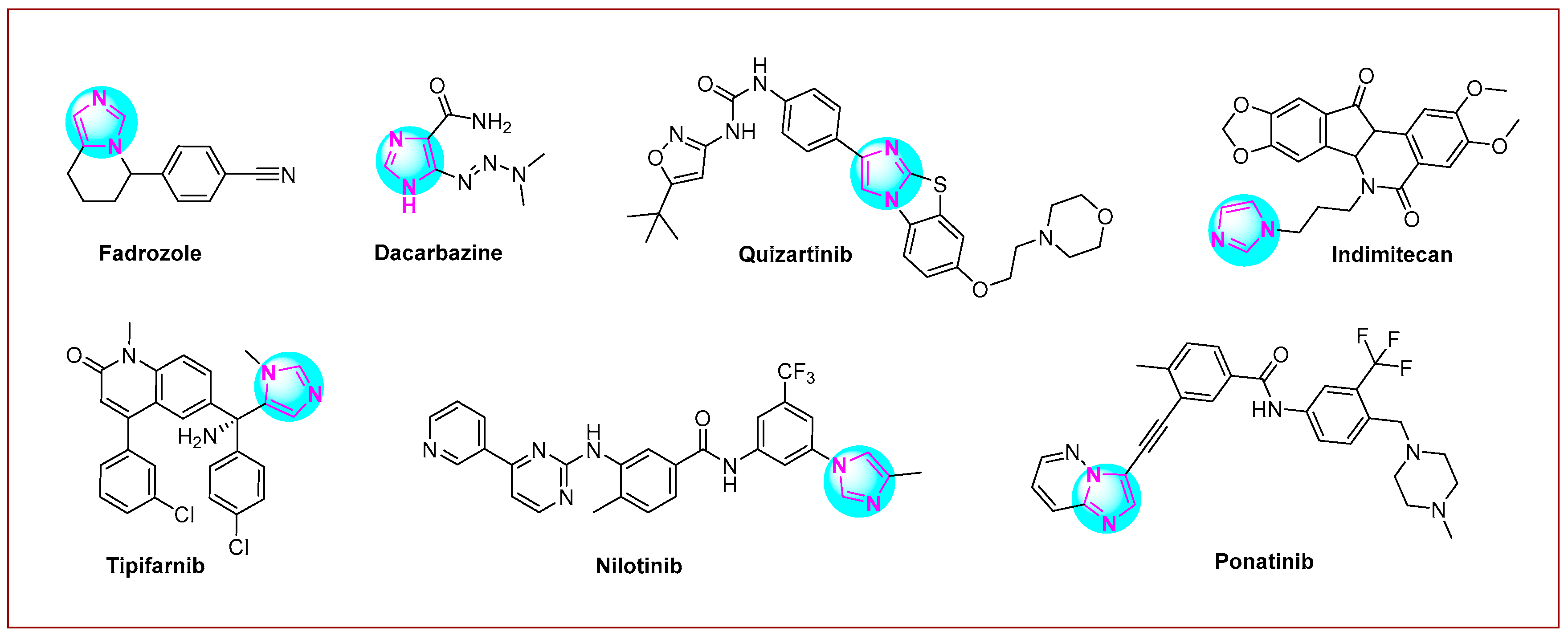
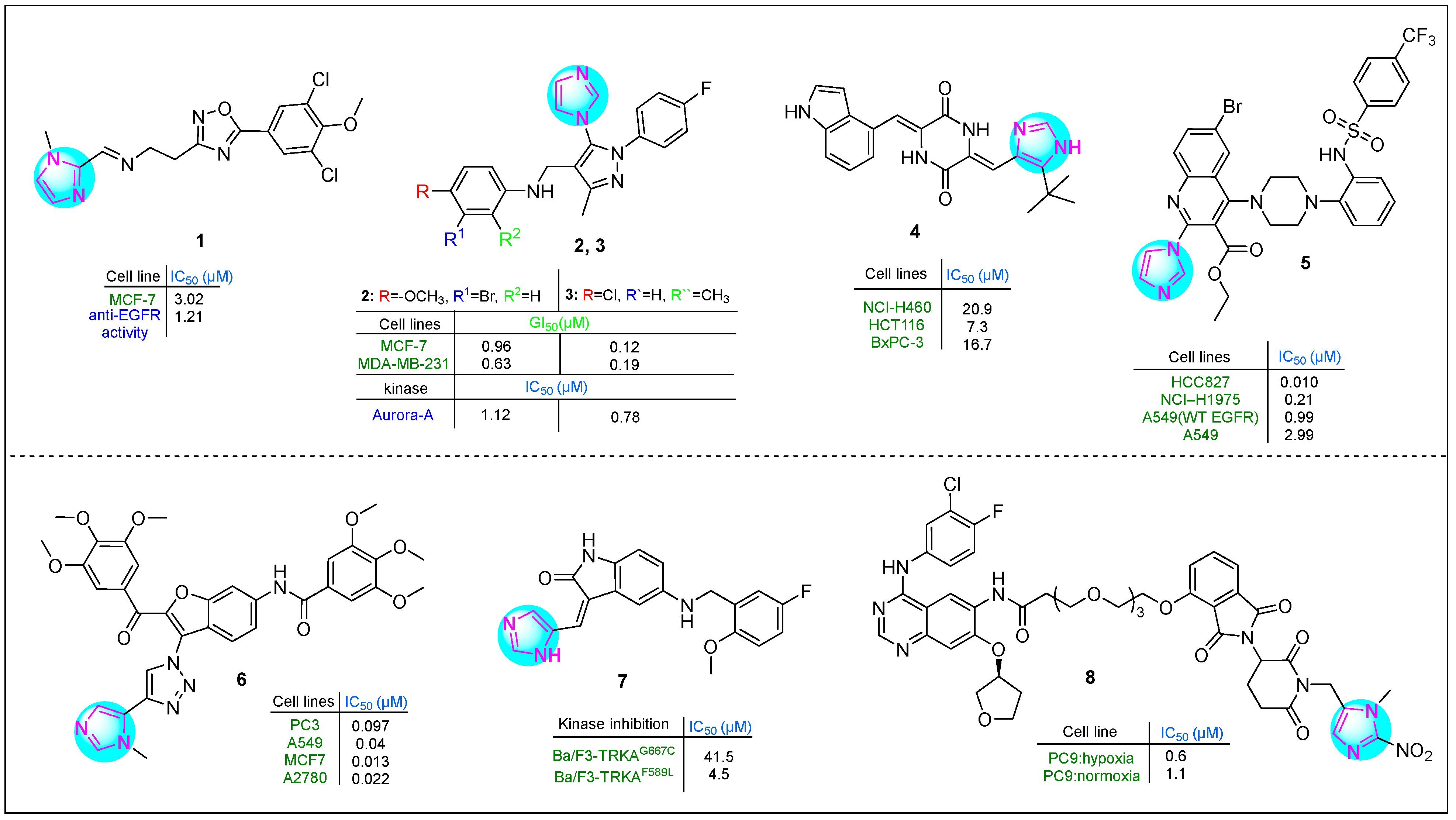
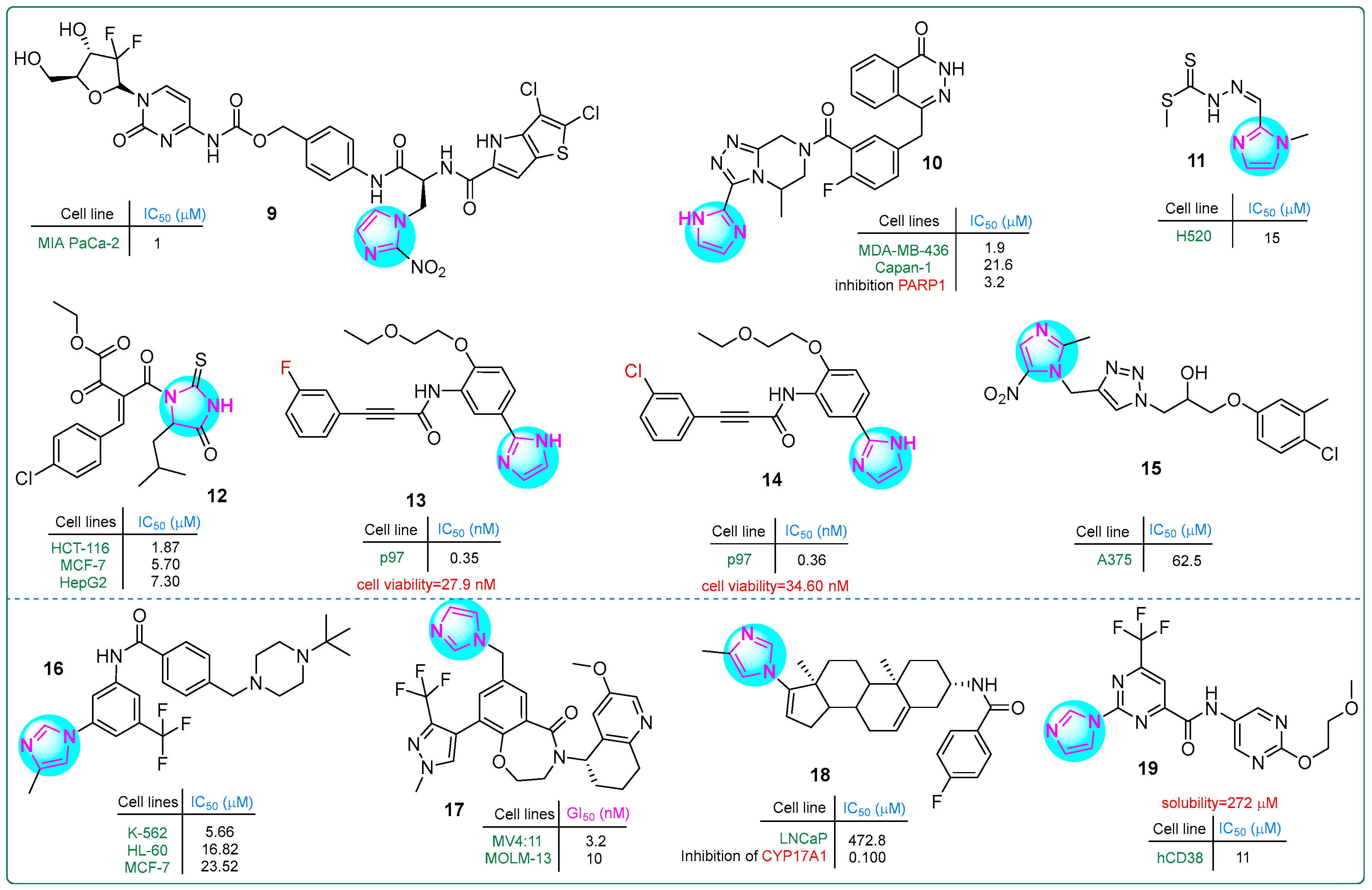
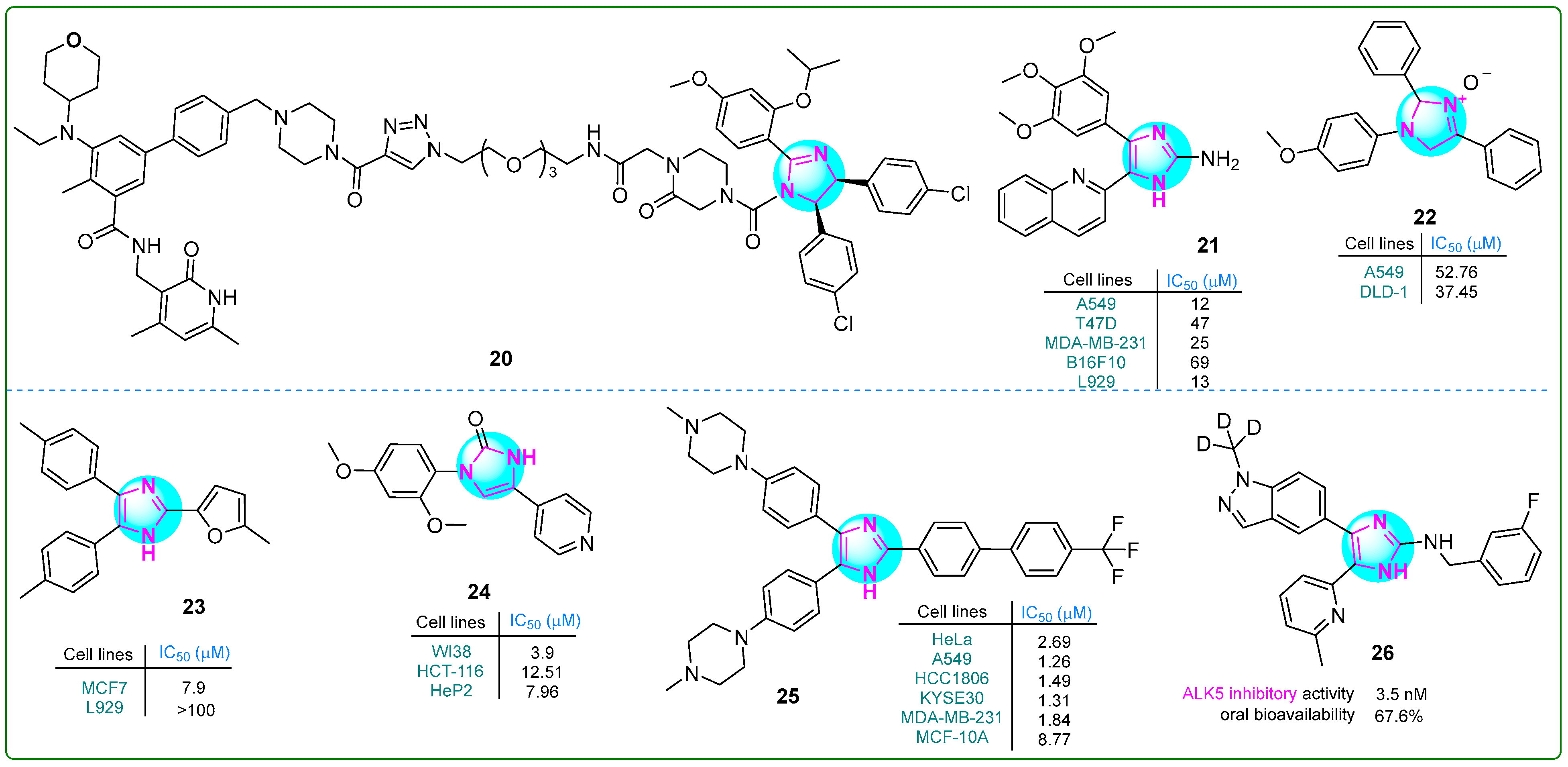
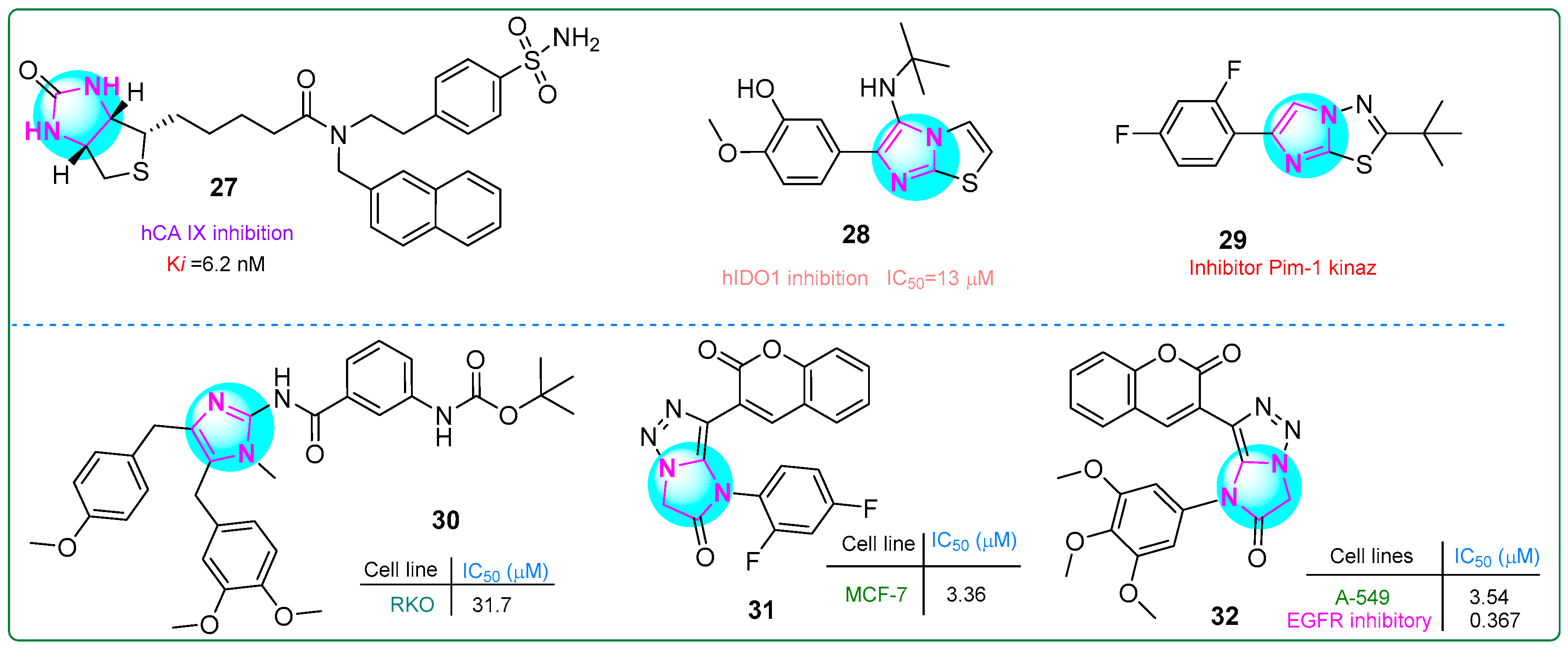


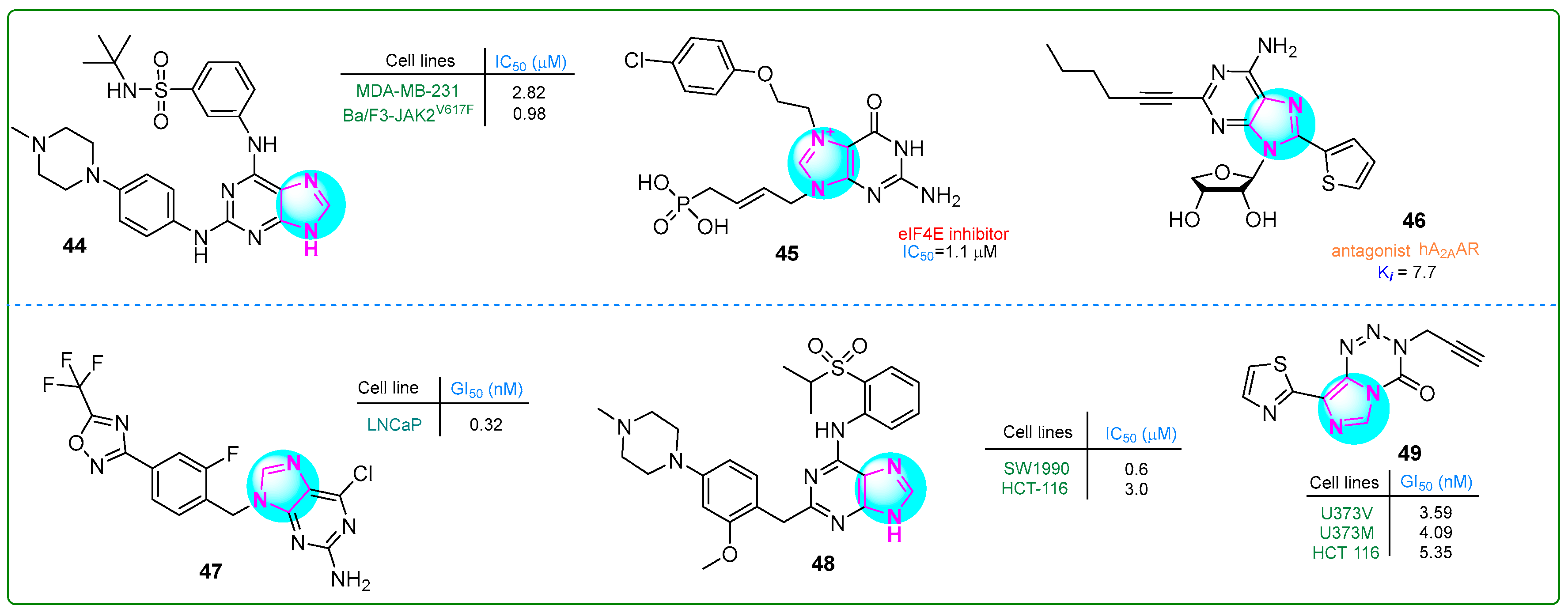



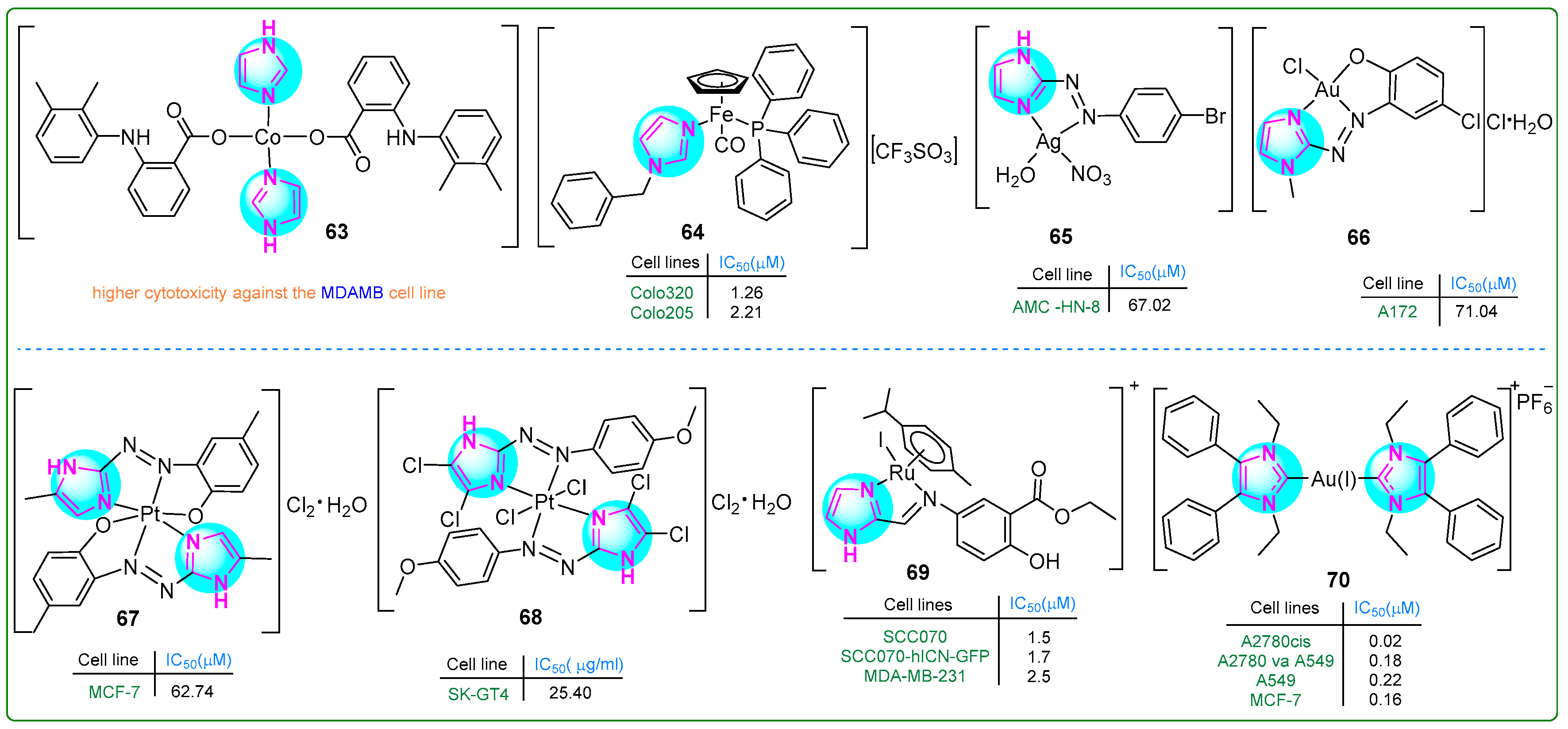
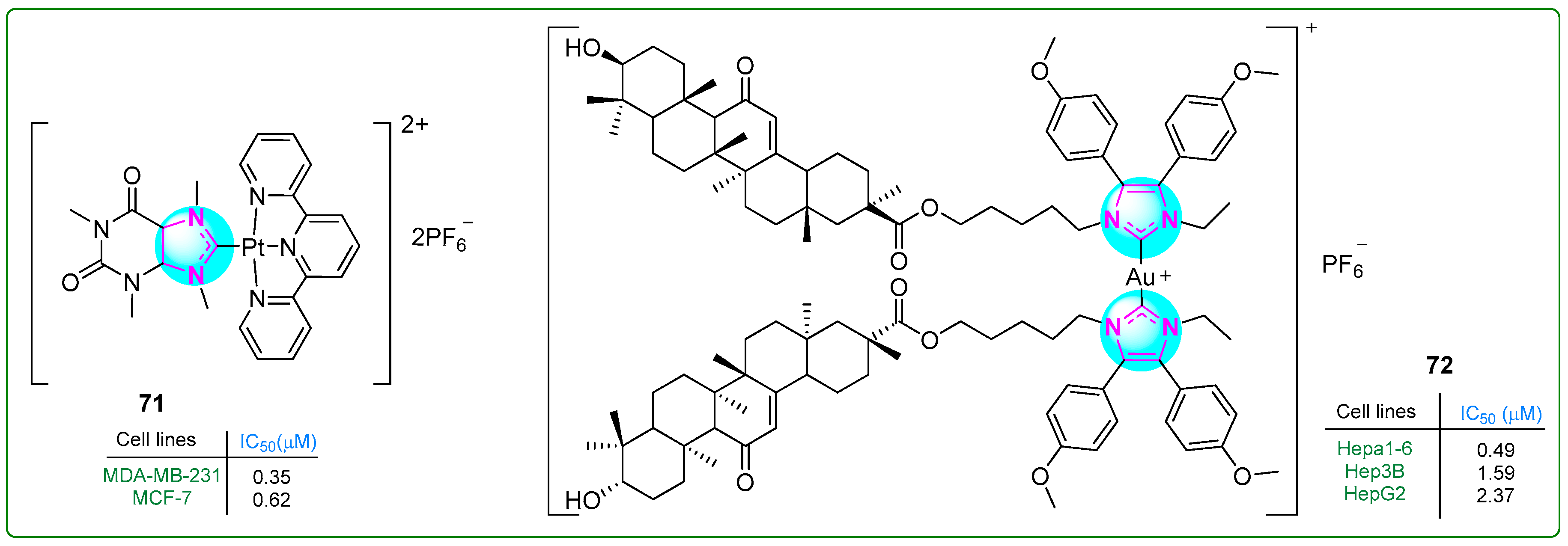
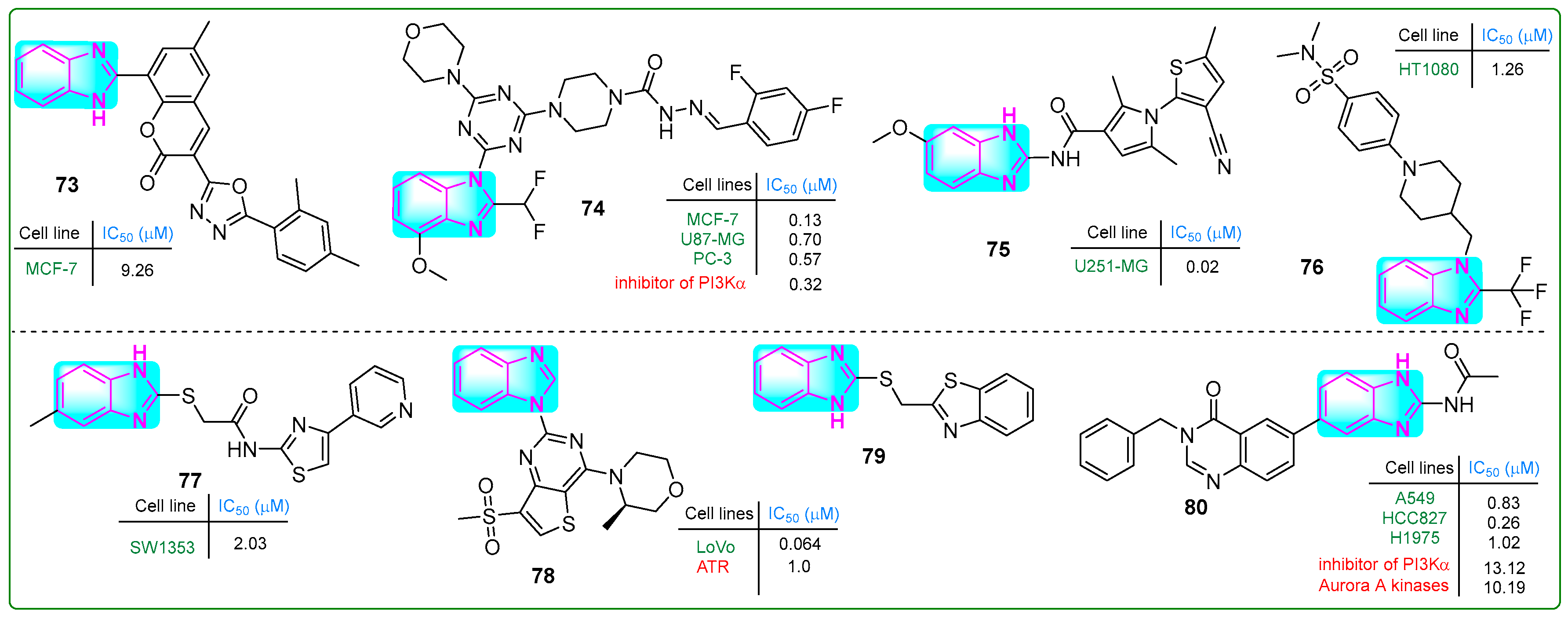
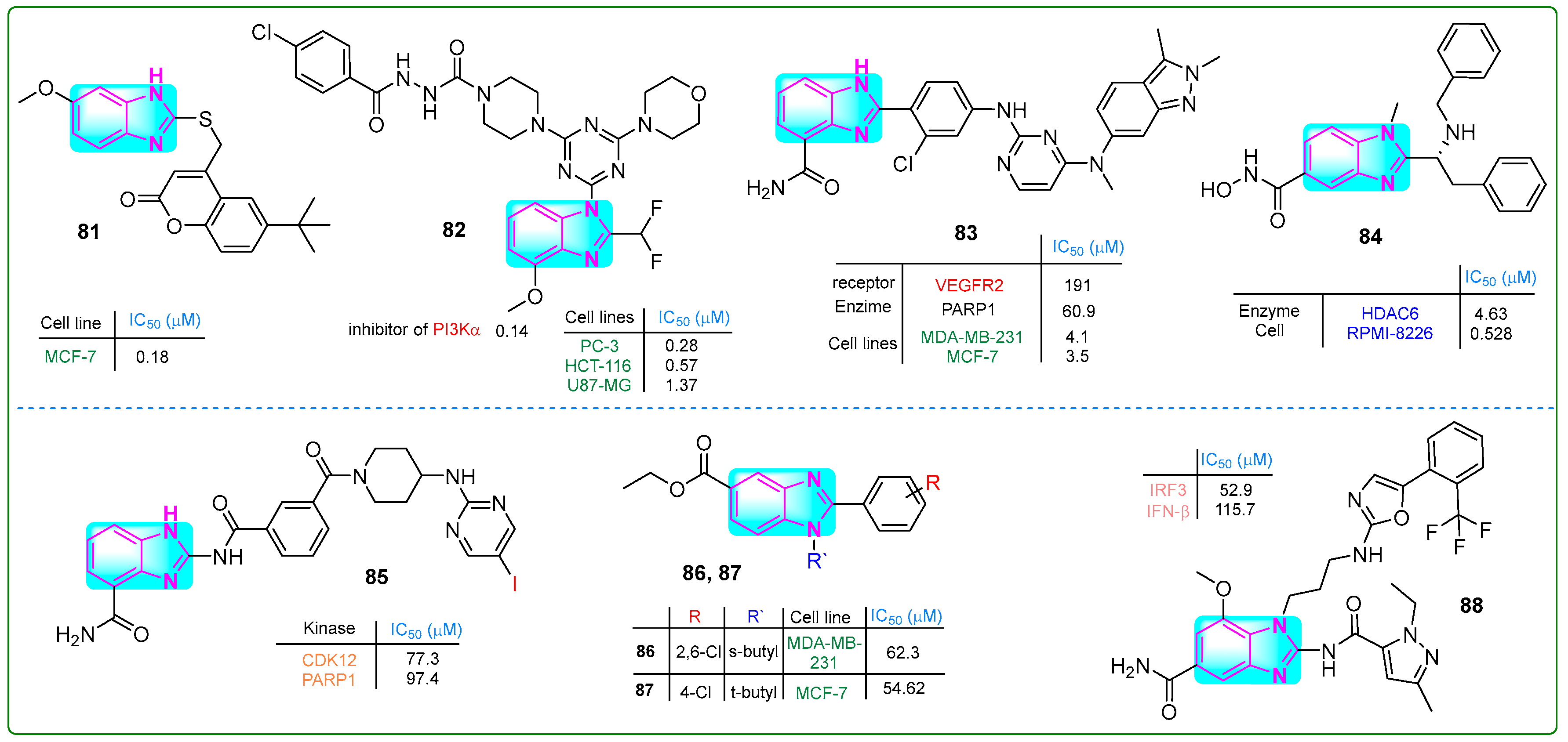

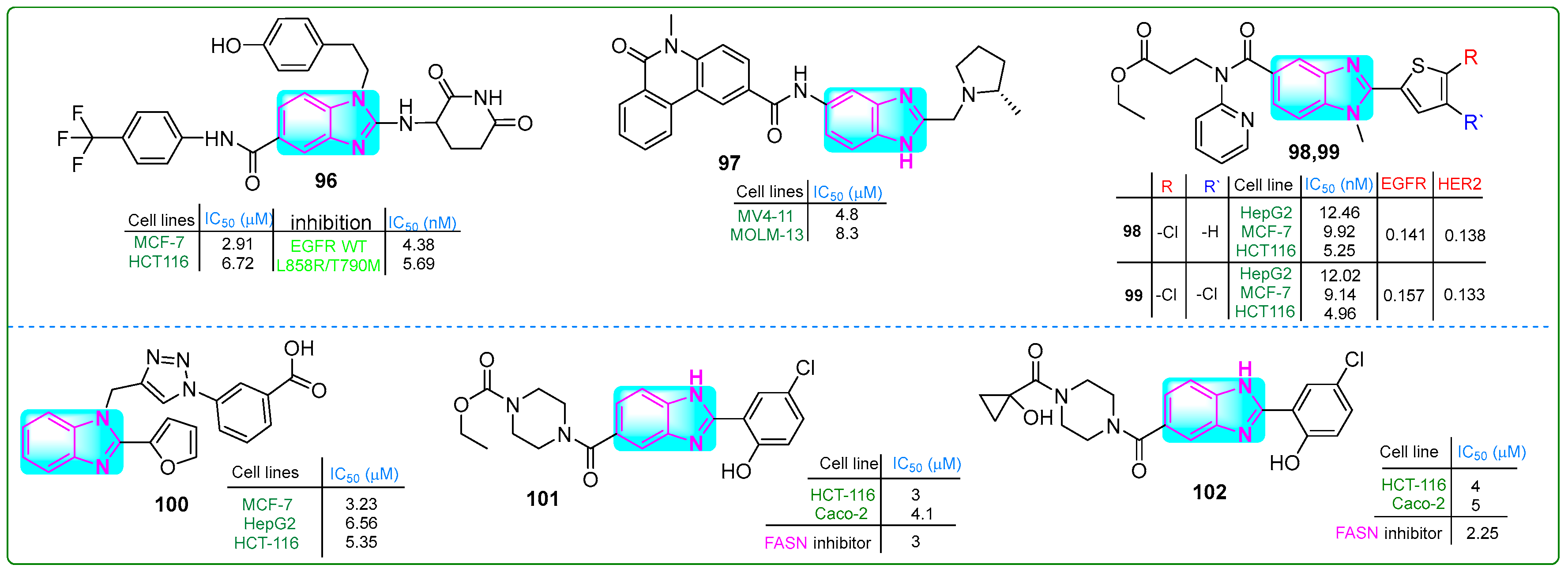
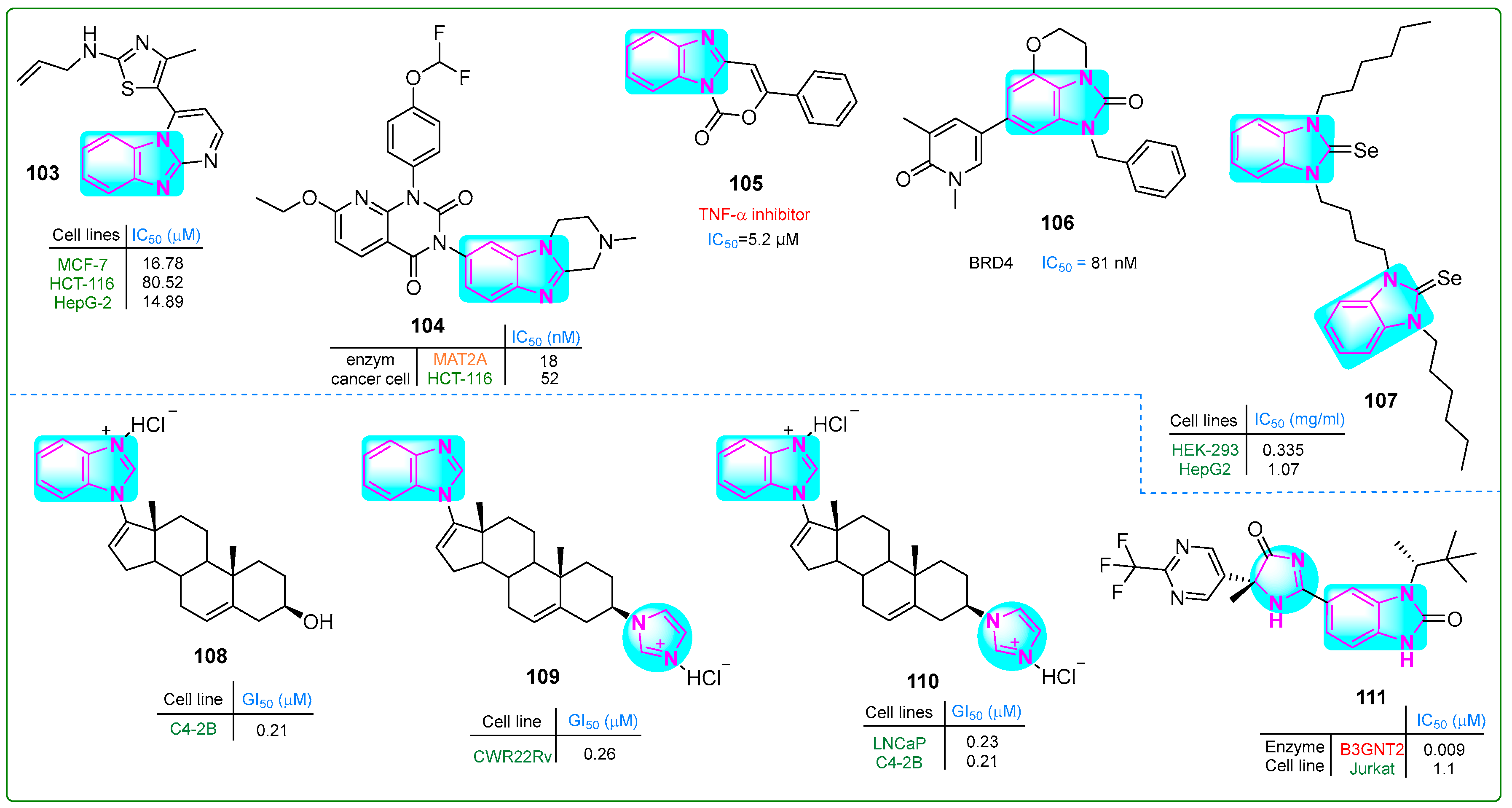

| Lead Compounds | Rings and Fragments Influencing Activity | Groups/Sections Enhancing Activity | Pharmacophore Substituents | Lead Compounds | Rings and Fragments Influencing Activity | Groups/Sections Enhancing Activity | Pharmacophore Substituents |
|---|---|---|---|---|---|---|---|
| 1 | 1,2,4-Oxadiazole | Azomethine | -OCH3 | 59 | Naphtho/imidazole | Phenyl | -NO2 |
| 2 | Pyrazole | -NH-CH2- | -OCH3 | 60 | Naphtho/imidazole | Phenyl | -OCH3 |
| 3 | Pyrazole | -NH-CH2- | -F | 61 | Naphtho/imidazole | Phenyl | -Cl |
| 4 | Piperazine-2,5-dione | Indole | -Bn | 62 | Anthra/imidazolium | Carbonyl | -CH3 |
| 5 | Piperazine | Sulfonamide | -CF3 | 63 | Co | Amide | -CH3 |
| 6 | Benzofuran, triazole | Amide | -OCH3 | 64 | Fe | Phenylphosphane | -Bn |
| 7 | Indolin-2-one | -NH-CH2- | -OCH3 | 65 | Ag | Imine | -Br |
| 8 | Quinazoline, indolinone | Amide | -Cl, -F | 66 | Au | Imine | -Cl |
| 9 | Pyrimidine, thiophene | Amide | -F, -Cl, -Bn | 67 | Pt | Imine | -CH3 |
| 10 | Pyrazine, triazole | Amide | -F, -Bn | 68 | Pt | Imine | -Cl, -OCH3 |
| 11 | Azomethine, thione | Imine | -CH3 | 69 | Ru | Azomethine | -OH |
| 12 | Thione | Carbonyl | -Cl, -Bn | 70 | Au | poly-phenyl | -C2H5 |
| 13 | Ethoxy/ethoxy | Amide | -F | 71 | Pt, pyrimidine, purine | Carbonyl | -CH3 |
| 14 | Ethoxy/ethoxy | Amide | -Cl | 72 | Au | Methylene bridge | -OCH3 |
| 15 | Triazole | Phenoxy | -Cl, -OH | 73 | Chromenone | Oxadiazole | -CH3 |
| 16 | Piperazine | Amide | -CF3 | 74 | Triazine, piperazine | Imine, morpholine | -F |
| 17 | Quinoline | Oxazepinone | -CF3, -OCH3 | 75 | Pyrrole, thiophene | Amide | -CH3, -OCH3 |
| 18 | Cyclopenta/phenanthren | Amide | -F | 76 | Piperidine | Sulfonamide | -CF3 |
| 19 | Pyrimidine | Amide | -CF3 | 77 | Thiazole, pyridine | Amide | -CH3 |
| 20 | Triazole, piperazine | Amide | -Cl | 78 | Thienopyrimidine | Morpholine | -S(O)2-CH3 |
| 21 | Quinoline | 3,4,5-tri-OCH3 | -OCH3 | 79 | Thiazole | Thioimidazole | -CH2- |
| 22 | di-Phenyl | Ph-4-OCH3 | -OCH3 | 80 | Quinazoline | Amide | Bn |
| 23 | Furyl | Ph-4-CH3 | -CH3 | 81 | Chromenone | Thioimidazole | -OCH3 |
| 24 | Pyridine | Carbonyl | -OCH3 | 82 | Triazine, piperazine | Morpholine, Amide | -Cl, -F, OCH3 |
| 25 | Piperazine | Biphenyl | -CF3 | 83 | Pyrimidine, Pyrazole | Amide | -Cl, -CH3 |
| 26 | Pyrazole, pyridine | -NH-CH2- | -F | 84 | Bis-benzyl | Amide | -OH |
| 27 | Thieno[3,4-d]imidazole | Sulfamide | -[-CH2]- | 85 | Pyrimidine | Piperidine | -I |
| 28 | Imidazo[2,1-b]thiazole | tert-Bu-NH2 | -OCH3 | 86 | Phenylimidazole | Ester | -Cl |
| 29 | Imidazo/thiadiazole | tert-Bu | -F | 87 | Phenylimidazole | Ester | -Bu |
| 30 | di-Benzyl | Amide | -OCH3 | 88 | Oxazole, pyrazole | Methylene bridge, amide | -CF3 |
| 31 | Imidazo/triazole | Chromen | -F | 89 | Pyrazole | Methylene bridge, amide | -F, -OCH3 |
| 32 | Imidazo/triazole | Chromen | -OCH3 | 90 | Quinoline | Amide | -NH2 |
| 33 | Imidazo/pyridine, Pyrimidine | Amide | -OCH3 | 91 | Thiadiazole, | Piperazine | -F, -CF3 |
| 34 | Imidazo/pyridine | Methylene bridge | -COOH | 92 | Nicotinamide | Methylene bridge, Amide | -CH3 |
| 35 | Imidazo/pyridine | Methylene bridge | -COOH, -OH | 93 | Indazole, furan | Amide | -NH2 |
| 36 | Imidazo/pyridazine | Amide | -F | 94 | Piperidine | Pyridinone | -CH3 |
| 37 | Imidazo/pyridazine | Oxazole | -N-(Et)2 | 95 | Pyrrolopyrimidine, piperazine | Pyrazole | -Pr |
| 38 | Imidazo/pyridazine; triazole | Morpholine, sulfamide | -[-CH2]-, -F | 96 | Dioxopiperidine | Amide | -CF3 |
| 39 | Imidazo/pyridine, indoline | Methylene bridge | -S(O)2-CH3 | 97 | Pyrrolidine | Amide | -CH2-, -CH3 |
| 40 | Imidazo/pyridine, quinoline | Methylene bridge | -S(O)2-CH3 | 98 | Thiophene | Methylene bridge, amide | -Cl |
| 41 | Imidazo/pyridine, indole | 3,4,5-tri-OCH3 | -OCH3 | 99 | Thiophene | Amide | -Cl |
| 42 | Imidazo/pyridazine, piperazine | Amide, pyrrolidine | -CF3 | 100 | Triazole | Methylene bridge | -COOH |
| 43 | Imidazo/pyridazine, piperazine | Methylene bridge | -CH3 | 101 | Piperazine | Carbonyl | -Cl |
| 44 | Purine, piperazine | Sulfamide | -CH3 | 102 | Piperazine | Carbonyl | -Cl |
| 45 | Purine | Methylene bridge, phosphone | -Cl | 103 | Thiazole | Imine | -CH3 |
| 46 | Purine, thiophene | Methylene bridge | -OH | 104 | Pyridopyrimidine | Methylpiperazine | -CH3 |
| 47 | Purine | Oxadiazole | -Cl, -CF3 | 105 | Chromen | Carbonyl | -Ph |
| 48 | Purine, piperazine | Sulfone | -OCH3 | 106 | Oxo-dihydropyrimidine | Morpholine, carbonyl | -Bn |
| 49 | Imidazo/tetrazinone | Thiazole | -Propynyl | 107 | Bis-benzimidazole | Methylene bridge | -CH3 |
| 50 | Benzamide, pyrrole | Sulfamide | -Cl | 108 | Galeterone (benzimidazole portion) | Galeterone (steroid portion) | -CH3, -OH |
| 51 | Pyrrole | Amide, Methylene bridge | -CH3 | 109 | Galeterone (benzimidazole portion) | Galeterone (steroid portion) | -CH3 |
| 52 | Purine, Imidazo/thiazole | Methylene bridge | -CH3 | 110 | Galeterone (benzimidazole portion) | Galeterone (steroid portion) | -CH3 |
| 53 | Imidazo/oxazole | 3,4,5-tri-OCH3 | -Br, -OCH3 | 111 | Pyrimidine | Carbonyl | -CF3 |
| 54 | Purine | Phosphone | -F | 112 | Bis-benzimidazole | Morpholine | -F |
| 55 | Purine | Thione | -CH3, -OH | 113 | Ru | Biphenyl | -Cl |
| 56 | Purine | Thiadiazine | -Ph | 114 | Ru | Biphenyl | -Ph |
| 57 | Quinazoline | Amine | -OCH3 | 115 | Ir | -[-CH = CH-]- | -CH3 |
| 58 | Purine | Thiazepine | -Cl | 116 | Co | Azomethine | -Br |
Disclaimer/Publisher’s Note: The statements, opinions and data contained in all publications are solely those of the individual author(s) and contributor(s) and not of MDPI and/or the editor(s). MDPI and/or the editor(s) disclaim responsibility for any injury to people or property resulting from any ideas, methods, instructions or products referred to in the content. |
© 2025 by the authors. Licensee MDPI, Basel, Switzerland. This article is an open access article distributed under the terms and conditions of the Creative Commons Attribution (CC BY) license (https://creativecommons.org/licenses/by/4.0/).
Share and Cite
Murtazaeva, Z.; Nasrullaev, A.; Buronov, A.; Gaybullaev, S.; Nie, L.; Numonov, S.; Khushnazarov, Z.; Turgunov, D.; Kuryazov, R.; Zhao, J.; et al. Imidazole Hybrids: A Privileged Class of Heterocycles in Medicinal Chemistry with New Insights into Anticancer Activity. Molecules 2025, 30, 2245. https://doi.org/10.3390/molecules30102245
Murtazaeva Z, Nasrullaev A, Buronov A, Gaybullaev S, Nie L, Numonov S, Khushnazarov Z, Turgunov D, Kuryazov R, Zhao J, et al. Imidazole Hybrids: A Privileged Class of Heterocycles in Medicinal Chemistry with New Insights into Anticancer Activity. Molecules. 2025; 30(10):2245. https://doi.org/10.3390/molecules30102245
Chicago/Turabian StyleMurtazaeva, Zarifa, Azizbek Nasrullaev, Anvarjon Buronov, Shukhrat Gaybullaev, Lifei Nie, Sodik Numonov, Zohidjon Khushnazarov, Davron Turgunov, Rustamkhon Kuryazov, Jiangyu Zhao, and et al. 2025. "Imidazole Hybrids: A Privileged Class of Heterocycles in Medicinal Chemistry with New Insights into Anticancer Activity" Molecules 30, no. 10: 2245. https://doi.org/10.3390/molecules30102245
APA StyleMurtazaeva, Z., Nasrullaev, A., Buronov, A., Gaybullaev, S., Nie, L., Numonov, S., Khushnazarov, Z., Turgunov, D., Kuryazov, R., Zhao, J., & Bozorov, K. (2025). Imidazole Hybrids: A Privileged Class of Heterocycles in Medicinal Chemistry with New Insights into Anticancer Activity. Molecules, 30(10), 2245. https://doi.org/10.3390/molecules30102245









